#What is virtual manufacturing ?
Explore tagged Tumblr posts
Text
One of the great things about fiber arts (at least to me) is that... you outright own the things you make. It's hard for me to comprehend actually owning something, and that's that. The item you have created doesn't need to come with strings attached (pun intended).
In a world where you are constantly buying things but not owning any of it, truly, it's such an odd experience to actually have ownership of your labour, time, and love like that.
#art#fiber art#crochet#honestly that's how i feel with my blanket still#like i don't own my subscription to spotify or the games i virtually purchased fullprice (which. why)...#...but when i get my yarn and i use the crochet hook i have been abusing a little i OWN the things it and i make#that's honestly kind of intimidating to me because i haven't truly felt i owned anything. like not even my life. it's a problem.#i just got some pretty yarn to use for a cardigan. they told me to use acrylic but i can't wear acrylic and i like cotton#<it's insane that i can just Decide to not use the pattern recommendations. like that's still crazy to me#anyway fuck capitalism and adopt a craft if you can#it's SUCH a freeing experience and it will make you feel crazy once you know what it feels like to actually own your labour. lol.#like it doesn't matter WHAT craft it is. could be knit. could be wood burning. could be abstract car manufacturing...#...as long as you can do it safely to your standards and you are satisfied and fulfilled with it then it can change you. let it change you.
95 notes
·
View notes
Text
17/12/23 this masterlist has been completely revamped with free access to all material. It will be updated and edited periodically so please click on my username and reblog the current version directly from me if you're able.
14/8/24 reboosting this post with How to Help Palestine updated. Please scroll to the bottom to donate or boost the links.
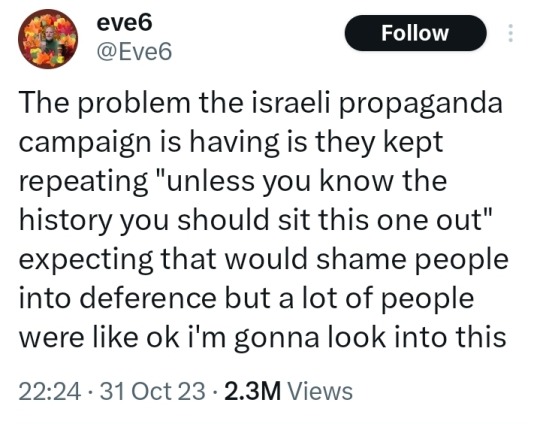


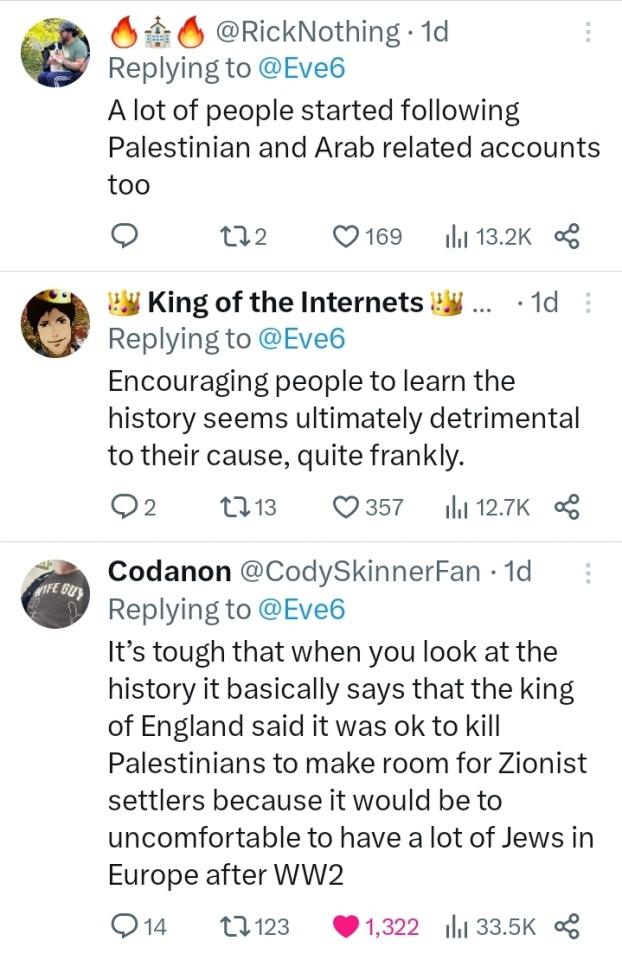
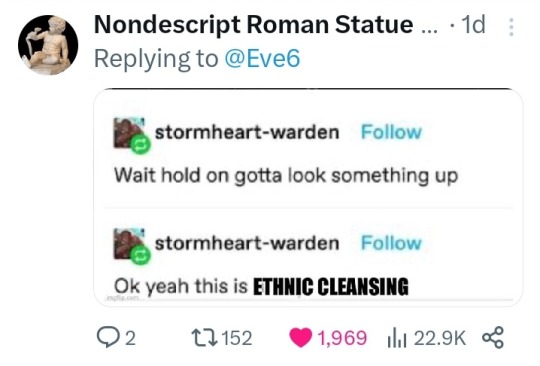
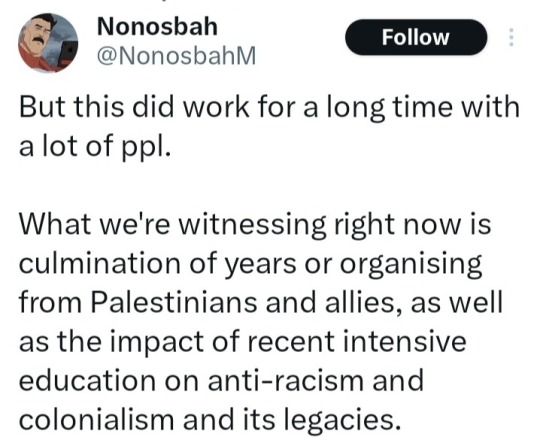
The Big Damn List Of Stuff They Said You Didn't Know
(Yes, it's a lot. Just choose your preferred medium and then pick one.)
Podcasts
Backgrounders and Quick Facts
Interactive Maps
Teach-Out Resources
Reading Material (free)
Films and Documentaries (free)
Non-Governmental Organizations
Social Media
How You Can Help <- URGENT!!!
Podcasts
Cocktails & Capitalism: The Story of Palestine Part 1, Part 3
It Could Happen Here: The Cheapest Land is Bought with Blood, Part 2, The Balfour Declaration
Citations Needed: Media narratives and consent manufacturing around Israel-Palestine and the Gaza Siege
The Deprogram: Free Palestine, ft. decolonizatepalestine.com.
Backgrounders and Quick Facts
The Palestine Academy: Palestine 101
Institute for Middle East Understanding: Explainers and Quick Facts
Interactive Maps
Visualizing Palestine
Teach-Out Resources
1) Cambridge UCU and Pal Society
Palestine 101
Intro to Palestine Film + Art + Literature
Resources for Organising and Facilitating)
2) The Jadaliya YouTube Channel of the Arab Studies Institute
Gaza in Context Teach-in series
War on Palestine podcast
Updates and Discussions of news with co-editors Noura Erakat and Mouin Rabbani.
3) The Palestine Directory
History (virtual tours, digital archives, The Palestine Oral History Project, Documenting Palestine, Queering Palestine)
Cultural History (Palestine Open Maps, Overdue Books Zine, Palestine Poster Project)
Contemporary Voices in the Arts
Get Involved: NGOs and campaigns to help and support.
3) PalQuest Interactive Encyclopedia of the Palestine Question.
4) The Palestine Remix by Al Jazeera
Books and Articles
Free reading material
My Gdrive of Palestine/Decolonization Literature (nearly all the books recommended below + books from other recommended lists)
Five free eBooks by Verso
Three Free eBooks on Palestine by Haymarket
LGBT Activist Scott Long's Google Drive of Palestine Freedom Struggle Resources
Recommended Reading List
Academic Books
Edward Said (1979) The Question of Palestine, Random House
Ilan Pappé (2002)(ed) The Israel/Palestine Question, Routledge
Ilan Pappé (2006) The Ethnic Cleansing of Palestine, OneWorld Publications
Ilan Pappé (2011) The Forgotten Palestinians: A History of the Palestinians in Israel, Yale University Press
Ilan Pappé (2015) The Idea of Israel: A History of Power and Knowledge, Verso Books
Ilan Pappé (2017) The Biggest Prison On Earth: A History Of The Occupied Territories, OneWorld Publications
Ilan Pappé (2022) A History of Modern Palestine, Cambridge University Press
Rosemary Sayigh (2007) The Palestinians: From Peasants to Revolutionaries, Bloomsbury
Andrew Ross (2019) Stone Men: the Palestinians who Built Israel, Verso Books
Rashid Khalidi (2020) The Hundred Years’ War on Palestine: A History of Settler Colonialism and Resistance 1917–2017
Ariella Azoulay (2011) From Palestine to Israel: A Photographic Record of Destruction and State Formation, 1947-1950, Pluto Press
Ariella Azoulay and Adi Ophir (2012) The One-State Condition: Occupation and Democracy in Israel/Palestine, Stanford University Press.
Jeff Halper (2010) An Israeli in Palestine: Resisting Dispossession, Redeeming Israel, Pluto Press
Jeff Halper (2015) War Against the People: Israel, the Palestinians and Global Pacification
Jeff Halper (2021) Decolonizing Israel, Liberating Palestine: Zionism, Settler Colonialism, and the Case for One Democratic State, Pluto Press
Anthony Loewenstein (2023) The Palestine Laboratory: How Israel exports the Technology of Occupation around the World
Noura Erakat (2019) Justice for Some: Law and the Question of Palestine, Stanford University Press
Neve Gordon (2008) Israel’s Occupation, University of California Press
Joseph Massad (2006) The Persistence of the Palestinian Question: Essays on Zionism and the Palestinians, Routledge
Memoirs
Edward Said (1986) After the Last Sky: Palestine Lives, Columbia University PEdward Saidress
Edward Said (2000) Out of Place; A Memoir, First Vintage Books
Mourid Barghouti (2005) I saw Ramallah, Bloomsbury
Hatim Kanaaneh (2008) A Doctor in Galilee: The Life and Struggle of a Palestinian in Israel, Pluto Press
Raja Shehadeh (2008) Palestinian Walks: Into a Vanishing Landscape, Profile Books
Ghada Karmi (2009) In Search of Fatima: A Palestinian Story, Verso Books
Vittorio Arrigoni (2010) Gaza Stay Human, Kube Publishing
Ramzy Baroud (2010) My Father Was a Freedom Fighter: Gaza's Untold Story, Pluto Press
Izzeldin Abuelaish (2011) I Shall Not Hate: A Gaza Doctor’s Journey on the Road to Peace and Human Dignity, Bloomsbury
Atef Abu Saif (2015) The Drone Eats with Me: A Gaza Diary, Beacon Press
Anthologies
Voices from Gaza - Insaniyyat (The Society of Palestinian Anthropologists)
Letters From Gaza • Protean Magazine
Salma Khadra Jayyusi (1992) Anthology of Modern Palestinian Literature, Columbia University Press
ASHTAR Theatre (2010) The Gaza Monologues
Refaat Alreer (ed) (2014) Gaza Writes Back, Just World Books
Refaat Alreer, Laila El-Haddad (eds) (2015) Gaza Unsilenced, Just World Books
Cate Malek and Mateo Hoke (eds)(2015) Palestine Speaks: Narrative of Life under Occupation, Verso Books
Jehad Abusalim, Jennifer Bing (eds) (2022) Light in Gaza: Writings Born of Fire, Haymarket Books
Short Story Collections
Ghassan Kanafani, Hilary Kilpatrick (trans) (1968) Men in the Sun and Other Palestinian Stories, Lynne Rienner Publishers
Ghassan Kanafani, Barbara Harlow, Karen E. Riley (trans) (2000) Palestine’s Children: Returning to Haifa and Other Stories, Lynne Rienner Publishers
Atef Abu Saif (2014) The Book of Gaza: A City in Short Fiction, Comma Press
Samira Azzam, Ranya Abdelrahman (trans) (2022) Out Of Time: The Collected Short Stories of Samira Azzam
Sonia Sulaiman (2023) Muneera and the Moon; Stories Inspired by Palestinian Folklore
Essay Collections
Edward W. Said (2000) Reflections on Exile and Other Essays, Harvard University Press
Salim Tamari (2008) Mountain against the Sea: Essays on Palestinian Society and Culture, University of California Press
Fatma Kassem (2011) Palestinian Women: Narratives, histories and gendered memory, Bloombsbury
Ramzy Baroud (2019) These Chains Will Be Broken: Palestinian Stories of Struggle and Defiance in Israeli Prisons, Clarity Press
Novels
Sahar Khalifeh (1976) Wild Thorns, Saqi Books
Liyana Badr (1993) A Balcony over the Fakihani, Interlink Books
Hala Alyan (2017) Salt Houses, Harper Books
Susan Abulhawa (2011) Mornings in Jenin, Bloomsbury
Susan Abulhawa (2020) Against the Loveless World, Bloomsbury
Graphic novels
Joe Sacco (2001) Palestine
Joe Sacco (2010) Footnotes in Gaza
Naji al-Ali (2009) A Child in Palestine, Verso Books
Mohammad Sabaaneh (2021) Power Born of Dreams: My Story is Palestine, Street Noise Book*
Poetry
Fady Joudah (2008) The Earth in the Attic, Sheridan Books,
Ghassan Zaqtan, Fady Joudah (trans) (2012) Like a Straw Bird It Follows Me and Other Poems, Yale University Press
Hala Alyan (2013) Atrium: Poems, Three Rooms Press*
Mohammed El-Kurd (2021) Rifqa, Haymarket Books
Mosab Abu Toha (2022) Things You May Find Hidden in My Ear: Poems from Gaza, City Lights Publishers
Tawfiq Zayyad (2023) We Are Here to Stay, Smokestack Books*
The Works of Mahmoud Darwish
Poems
Rafeef Ziadah (2011) We Teach Life, Sir
Nasser Rabah (2022) In the Endless War
Refaat Alareer (2011) If I Must Die
Hiba Abu Nada (2023) I Grant You Refuge/ Not Just Passing
[All books except the ones starred are available in my gdrive. I'm adding more each day. But please try and buy whatever you're able or borrow from the library. Most should be available in the discounted Free Palestine Reading List by Pluto Press, Verso and Haymarket Books.]
Human Rights Reports & Documents
Information on current International Court of Justice case on ‘Legal Consequences arising from the Policies and Practices of Israel in the Occupied Palestinian Territory, including East Jerusalem’
UN Commission of Inquiry Report 2022
UN Special Rapporteur Report on Apartheid 2022
Amnesty International Report on Apartheid 2022
Human Rights Watch Report on Apartheid 2021
Report of the United Nations Fact-Finding Mission on the Gaza Conflict’ 2009 (‘The Goldstone Report’)
Advisory Opinion on the Legal Consequences of the Construction of a Wall in the Occupied Palestinian Territory, International Court of Justice, 9 July 2004
Films
Documentaries
Jenin, Jenin (2003) dir. Mohammed Bakri
Massacre (2005) dir. Monica Borgmann, Lokman Slim, Hermann Theissen
Slingshot HipHop (2008) dir. Jackie Reem Salloum
Waltz with Bashir (2008) dir. Ari Folman † (also on Amazon Prime)
Tears of Gaza (2010) dir. Vibeke Løkkeberg (also on Amazon Prime)
5 Broken Cameras (2011) dir. Emad Burnat (also on Amazon Prime)
The Gatekeepers (2012) dir. Dror Moreh (also on Amazon Prime)
The Great Book Robbery (2012) | Al Jazeera English
Al Nakba (2013) | Al Jazeera (5-episode docu-series)
The Village Under the Forest (2013) dir. Mark J. Kaplan
Where Should The Birds Fly (2013) dir. Fida Qishta
Naila and the Uprising (2017) (also on Amazon Prime)
GAZA (2019) dir. Andrew McConnell and Garry Keane
Gaza Fights For Freedom (2019) dir. Abby Martin
Little Palestine: Diary Of A Siege (2021) dir. Abdallah Al Khatib
Palestine 1920: The Other Side of the Palestinian Story (2021) | Al Jazeera World Documentary
Gaza Fights Back (2021) | MintPress News Original Documentary | dir. Dan Cohen
Innocence (2022) dir. Guy Davidi
Short Films
Fatenah (2009) dir. Ahmad Habash
Gaza-London (2009) dir. Dina Hamdan
Condom Lead (2013) dir. Tarzan Nasser, Arab Nasser
OBAIDA (2019) | Defence for Children Palestine
Theatrical Films
Divine Intervention (2002) | dir. Elia Suleiman (also on Netflix)
Paradise Now (2005) dir Hany Abu-Assad (also on Amazon Prime)
Lemon Tree (2008) (choose auto translate for English subs) (also on Amazon Prime)
It Must Be Heaven (2009) | dir. Elia Suleiman †
The Promise (2010) mini-series dir. Peter Kosminsky (Part 1, Part 2, Part 3, Part 4)
Habibi (2011)* dir. Susan Youssef
Omar (2013)* dir. Hany Abu-Assad †
3000 Nights (2015)* dir. Mai Masri
Foxtrot (2017) dir. Samuel Maoz (also on Amazon Prime)
The Time that Remains (2019) dir. Elia Suleiman †
Gaza Mon Amour (2020) dir. Tarzan Nasser, Arab Nasser †
The Viewing Booth (2020) dir. Ra'anan Alexandrowicz (on Amazon Prime and Apple TV)
Farha (2021)* | dir. Darin J. Sallam
Palestine Film Institute Archive
All links are for free viewing. The ones marked with a star (*) can be found on Netflix, while the ones marked † can be downloaded for free from my Mega account.
If you find Guy Davidi's Innocence anywhere please let me know, I can't find it for streaming or download even to rent or buy.
In 2018, BDS urged Netflix to dump Fauda, a series created by former members of IOF death squads that legitimizes and promotes racist violence and war crimes, to no avail. Please warn others to not give this series any views. BDS has not called for a boycott of Netflix. ]
NGOs
The Boycott, Divestment, Sanctions (BDS) Movement
Euro-Mediterranean Human Rights Monitor
UNRWA
Palestine Defence for Children International
Palestinian Feminist Collective
Al-Shabaka: The Palestinian Policy Network
Addameer Prisoner Support and Human Rights Association
Institute for Palestine Studies
Al Haq
Artists for Palestine
The Palestine Museum
Jewish Currents
B’Tselem
DAWN
Social Media
Palestnians on Tumblr
@el-shab-hussein
@killyfromblame
@apollos-olives
@fairuzfan
@palipunk
@sar-soor
@nabulsi
@wearenotjustnumbers2
@90-ghost
@tamarrud
@northgazaupdates
Allies and advocates (not Palestinian)
@bloglikeanegyptian beautiful posts that read like op-eds
@vyorei daily news roundups
@luthienne resistance through prose
@decolonize-the-left scoop on the US political plans and impacts
@feluka
@anneemay
(Please don't expect any of these blogs to be completely devoted to Palestine allyship; they do post regularly about it but they're still personal blogs and post whatever else they feel like. Do not harrass them.)
Gaza journalists
Motaz Azaiza IG: @motaz_azaiza | Twitter: @azaizamotaz9 | TikTok: _motaz.azaiza (left Gaza as of Jan 23)
Bisan Owda IG and TikTok: wizard_bisan1 | Twitter: @wizardbisan
Saleh Aljafarawi IG: @saleh_aljafarawi | Twitter: @S_Aljafarawi | TikTok: @saleh_aljafarawi97
Plestia Alaqad IG: @byplestia | TikTok: @plestiaaqad (left Gaza)
Wael Al-Dahdouh IG: @wael_eldahdouh | Twitter: @WaelDahdouh (left Gaza as of Jan 13)
Hind Khoudary IG: @hindkhoudary | Twitter: @Hind_Gaza
Ismail Jood IG and TikTok: @ismail.jood (announced end of coverage on Jan 25)
Yara Eid IG: @eid_yara | Twitter: @yaraeid_
Eye on Palestine IG: @eye.on.palestine | Twitter: @EyeonPalestine | TikTok: @eyes.on.palestine
Muhammad Shehada Twitter: @muhammadshehad2
(Edit: even though some journos have evacuated, the footage up to the end of their reporting is up on their social media, and they're also doing urgent fundraisers to get their families and friends to safety. Please donate or share their posts.)
News organisations
The Electronic Intifada Twitter: @intifada | IG: @electronicintifada
Quds News Network Twitter and Telegram: @QudsNen | IG: @qudsn (Arabic)
Times of Gaza IG: @timesofgaza | Twitter: @Timesofgaza | Telegram: @TIMESOFGAZA
The Palestine Chronicle Twitter: @PalestineChron | IG: @palestinechron | @palestinechronicle
Al-Jazeera Twitter: @AJEnglish | IG and TikTok: @aljazeeraenglish, @ajplus
Middle East Eye IG and TikTok: @middleeasteye | Twitter: @MiddleEastEye
Democracy Now Twitter and IG: @democracynow TikTok: @democracynow.org
Mondoweiss IG and TikTok: @mondoweiss | Twitter: @Mondoweiss
The Intercept Twitter and IG: @theintercept
MintPress Twitter: @MintPressNews | IG: mintpress
Novara Media Twitter and IG: @novaramedia
Truthout Twitter and IG: @truthout
Noura Erakat: Legal scholar, human rights attorney, specialising in Israeli–Palestinian conflict. Twitter: @4noura | IG: @nouraerakat | (http://www.nouraerakat.com/)
Palestnians on Other Social Media
Taleed El Sabawi: Assistant professor of law and researcher in public health. Twitter: @el_sabawi | IG
Hebh Jamal: Journalist in Germany. IG and Twitter: @hebh_jamal
Lexi Alexander: Filmmaker and activist. Twitter: @LexiAlex | IG: @lexialexander1
Mariam Barghouti: Writer, blogger, researcher, and journalist. Twitter: @MariamBarghouti | IG: @mariambarghouti
Rasha Abdulhadi: Queer poet, author and cultural organizer. Twitter: @rashaabdulhadi
Mohammed el-Kurd: Writer and activist from Jerusalem. IG: @mohammedelkurd | Twitter: @m7mdkurd
Ramy Abdu: Founder and Chairman of the Euro-Mediterranean Human Rights Monitor. Twitter: @RamyAbdu
‼️How You Can Help Palestine‼️
Subhi: Founder of The Palestine Academy website. IG: @sbeih.jpg |TikTok @iamsbeih | Twitter: @iamsbeih
Click for Palestine (Please reblog!!)
Masterlist of donation links by @sulfurcosmos (Please reblog!!)
Water for Gaza: Donate directly to the Gaza Municipality
Gazafunds (vetted and spotlighted GFMs)
The Butterfly Effect Project (spreadsheet of vetted GFMs)
Operation Olive Branch Linktree for vetted fundraisers, donations and political action resources. TikTok and Instagram: @operationolivebranch | Twitter: @OPOliveBranch
Spreadsheet of Gaza fundraisers vetted by @el-shab-hussein and @nabulsi
Political action to pressure the Harris campaign to stop arming Israel (for US citizens): Uncommitted Movement (TikTok: @uncommittedmvmt) (Please reblog!!)
If any links are broken let me know. Or pull up the current post to check whether it's fixed.
"Knowledge is Israel's worst enemy. Awareness is Israel's most hated and feared foe. That's why Israel bombs a university: it wants to kill openness and determination to refuse living under injustice and racism."
— Dr. Refaat Alareer, (martyred Dec 6, 2023)
From River To The Sea Palestine Will Be Free 🇵🇸🇵🇸🇵🇸
-----
Edit 1: took the first video down because turns out the animator is a terf and it links to her blog. Really sorry for any distress.
Edit 2: All recommended readings + Haymarket recommendations + essential decolonization texts have been uploaded to my linked gdrive. I will adding more periodically. Please do buy or check them out from the library if possible, but this post was made for and by poor and gatekept Global South bitches like me.
Some have complained about the memes being disrespectful. You're actually legally obligated to make fun of Israeli propaganda and Zionists. I don't make the rules.
Edit 3: "The river to the sea" does not mean the expulsion of Jews from Palestine. Believing that is genocide apologia.
Edit 4: Gazans have specifically asked us to put every effort into pushing for a ceasefire instead of donations. "Raising humanitarian aid" is a grift Western governments are pushing right now to deflect from the fact that they're sending billions to Israel to keep carpet bombing Gazans. As long as the blockades are still in place there will never be enough aid for two million people. (UPDATE: PLEASE DONATE to the Gazan's GoFundMe fundraisers to help them buy food and get out of Rafah into Egypt. E-SIMs, food and medical supplies are also essential. Please donate to the orgs linked in the How You Can Help. Go on the strikes. DO NOT STOP PROTESTING.)
Edit 5: Google drive link for academic books folder has been fixed. Also have added a ton of resources to all the other folders so please check them out.
Edit 6: Added interactive maps, Jadaliya channel, and masterlists of donation links and protest support and of factsheets.
The twitter accounts I reposted as it was given to me and I just now realized it had too many Israeli voices and almost none of the Palestinians I'm following, so it's being edited. (Update: done!) also removed sources like Jewish Voices of Peace and Breaking the Silence that do good work but have come under fair criticism from Palestinians.
Edit 7: Complete reformatting
Edit 8: Complete revamping of the social media section. It now reflects my own following list.
Edit 9: removed some more problematic people from the allies list. Remember that the 2SS is a grift that's used to normalize violence and occupation, kids. Supporting the one-state solution is lowest possible bar for allyship. It's "Free Palestine" not "Free half of Palestine and hope Israel doesn't go right back to killing them".
Edit 10: added The Palestine Directory + Al Jazeera documentary + Addameer. This "100 links per post" thing sucks.
Edit 11: more documentaries and films
Edit 12: reformatted reading list
Edit 13: had to remove @palipunk's masterlist to add another podcast. It's their pinned post and has more resources Palestinian culture and crafts if you want to check it out
Edit 14 6th May '24: I've stopped updating this masterlist so some things, like journalists still left in Gaza and how to support the student protests are missing. I've had to take a step back and am no longer able to track these things down on my own, and I've hit the '100 links per post' limit, but if you can leave suggestions for updates along with links in either the replies or my asks I will try and add them.
Edit 15 10th August: added to Palestinian allies list and reworked the Help for Palestine section. There's been a racist harrassment campaign against the Palestinian Tumblrs that vetted the Gaza fundraisers based off one mistake made by a Gazan who doesn't understand English. If you're an ally, shut that shit down. Even if you donate to a scam GFM, you're only out some coffee money; if everyone stops donating to all the GFMs in fear of scams, those families die.
#free palestine#palestine resources#palestine reading list#decolonization#israel palestine conflict#israel palestine war#british empire#american imperialism#apartheid#social justice#middle east history#MENA#arab history#anti zionism#palestinian art#palestinian history#palestinian culture#palestinian genocide#al nakba#ethnic cleansing#war crimes#racism#imperialism#colonialism#british colonialism#knee of huss#ask to tag#Youtube
83K notes
·
View notes
Text
What is meant by virtual manufacturing?
Virtual manufacturing refers to the use of computer-based simulation, modeling, and other digital technologies to design, test, and optimize manufacturing processes and products before they are physically created. It is an integral part of Industry 4.0 and leverages advanced software and tools to replicate the behavior of manufacturing systems in a virtual environment. This approach reduces risks, costs, and time associated with product development and process planning.
Key Aspects of Virtual Manufacturing:
Simulation of Manufacturing Processes:
Simulates production workflows, machinery operations, and material handling to predict outcomes and identify bottlenecks.
Digital Twins:
Creation of digital replicas of physical systems or products to monitor performance, optimize processes, and implement real-time adjustments.
Product Design and Testing:
Virtual testing of prototypes for performance, quality, and manufacturability without creating physical samples.
Process Optimization:
Analyzes and improves efficiency, throughput, and resource utilization in manufacturing operations.
Cost and Time Reduction:
Identifies potential problems early in the design and planning phase, reducing the need for physical trials and minimizing waste.
Enhanced Collaboration:
Enables stakeholders across different locations to collaborate on design and manufacturing processes in a virtual environment.
0 notes
Text
Had a virtual appointment with my doctor. And she just?? Listened to me?? And took my opinion into account??? Like a rational human being????
I've been getting up 2-4 times a night to pee and peeing frequently during the day and she asked me "what are you looking for out of treatment" and I said "Ideally I would like a medication I could take in the evening that would last as long as I am sleeping and then wear off, but I know most meds aren't that specific" BUT THERE WAS!! A MEDICATION!! LIKE THAT!! She prescribed me a medication that's normally given to kids who wet the bed that mimics the hormone we naturally produce at night that keeps our kidneys from manufacturing as much urine. The wonders of modern medicine.
And then!! I was like "I'm having reactions to food and I'm fairly sure it's MCAS because last week I ate one of the foods and got itchy but before that it was racing heart/shaky/nauseous/feeling faint/feeling like I was gonna die and I just wanted to make sure you didn't think I needed to check my blood sugar" and she just??? Agreed with me!! She said "yeah you're right it's probably a combo of MCAS and POTS." Like!! She listened to me and just fucken. Agreed! No fight to justify myself!!
I feel like I won the lottery and if she ever quits I will be so so sad forever.
4K notes
·
View notes
Text
Elms guide for Logan Sargeant fans
Starting with what is the European Le Mans Series (ELMS):
It’s a European series of endurance races reserved for cars such as "Le Mans Prototypes" and "Le Mans Grand Touring". The ELMS presents three different categories: LMP2, LMP2 Pro/Am, LMP3 and LMGT3.
CATEGORIES
* There are 4 categories
* All 4 categories run at the same time on track
* The cars that are performing in those classes are all different in terms of weight, size, engine
Lmp2- Race Number Background Color: BLUE (what Logan is driving !!)
* The category below the top LMH class of the FIA World Endurance Championship (WEC) "Le Mans Prototype 2" (LMP2) is a key part of the “Endurance" family
* Each driver line up must have at least 1 silver or bronze driver, two platinum drivers can not be entered in the same line up
* it allows teams and drivers to progress to the highest level gradually.
* 1st and 2nd LMP2 competitors will be invited to the 2024 24 Hours of Le Mans.
Lmp2 pro/am- Race Number Background Color: CYAN
* In 2021, the LMP2 grid included a separate trophy and title for competitors whose cars included a bronze driver in their line-up. This was known as LMP2 Pro/Am.
* In a change for the 2023 season, the LMP2 Pro/Am category will be run as a separate class
* a lineup of 2 or 3 drivers must include at least 1 bronze driver
* The cars will be the same as run in the LMP2 category.
* 1st LMP2 Pro/Am competitor will be invited to 2024 24 Hours of Le Mans.
LMP3- Race Number Background Color: PURPLE
* LMP3 was designed as a training ground for endurance racing, an arena in which drivers, team members, engineers, and mechanics can hone their skills and prepare for the 24 Hours of Le Mans and the FIA World Endurance Championship.
* lineup must include 1 silver and 1 bronze or 2 bronze
* from what I understand, it is a feeder series similar to f2/f3
Lmgt3- Race Number Background Color: ORANGE
* Le Mans Grand Touring Car, is a set of regulations maintained by the ACO and the FIA for Grand Tourer race cars designed for use in the ACO/FIA motor racing series. *LMGT3 cars are based on production road car models that are built and sold at the time of homologation.
* Cars eligible for the LMGT3 class must be built by a partner manufacturer recognized by the ACO/FIA
* a lineup of 2 or 3 drivers must have 1 silver and 1 bronze or 2 bronze and no more than 1 gold or platinum driver
TYRES
* LMP2, LMP2 Pro/Am, and LMGT3 competitors run with Goodyear tyres. LMP3 competitors run with Michelin tyres.
* LMP2, LMP2 Pro/Am, and LMP3 competitors have one dry and one wet tyre specifications. There are two dry and one wet tyre specifications for the LMGT3 category.
* Unlike Formula 1, any equipment for warming the tyres or keeping them to temperature is forbidden.
RACE WEEKENDS
WEEKEND SETUP
* Free Practice: two Free Practice sessions of 90 minutes.
* Bronze Test: one session of 30 minutes exclusively for FIA-ranked Bronze drivers.
* Qualifying: one qualifying session of 15 minutes per category, which defines the grid order.
* In LMP2 Pro/Am and LMGT3, only Bronze drivers can qualify for the car, whereas in LMP2 and LMP3, it's up to the competitor.
* Race – which lasts 4 hours.
RACES
* Each driver must drive at least 40 minutes during the race. (One stint)
* The winner is the car that covered the greatest distance in their category.
RACE NEUTRALISATION
* If the race needs to be neutralized or stopped for safety reasons, multiple procedures can be decided by the Race Director:
FULL COURSE YELLOW
* Intended for short neutralisations, mainly for interventions lasting equal to or less than one lap.
* Cars must slow down to 80kph.
* The pit lane entry is closed when there is a Full Course Yellow (FCY)
* No overtaking
VIRTUAL SAFETY CAR
* Intended to secure interventions and used for an approximate duration of two laps before deployment of the Safety Car (SC).
* Cars must slow down to 80kph.
* Access to the pit lane will remain open for the duration of the VSC.
* No overtaking
SAFETY CAR
* Intended for long neutralizations.
* All cars must follow the Safety Car and adapt their speed.
* The pit lane entry is closed for three laps when a Safety Car (SC) is announced.
* Overtaking is permitted under defined circumstances.
RED FLAG
* All the cars must head back to the pitlane or stop on track according to the conditions.
PODIUMS
* Each category has its own podium for the three first competitors.
STANDINGS
* Cars and drivers have their own classification in each category.
* One point is awarded for the pole position in each category.
* Points are awarded to the following scale:
1. 25 point
2. 18 points
3. 15 points
4. 12 points
5. 10 points
6. 8 points
7. 6 points
8. 4 points
9. 2 points
10. 1 point
AUTOMATIC INVITATIONS TO THE 2025 24 HOURS OF LE MANS
Okay, like I said before- the teams in these series get invited to WEC Le Mans.
* LMP2: 1st and 2nd placed competitors in the overall classifications will receive LMP2 invitations.
* LMP2 Pro/Am: 1st placed competitor in the overall classifications will receive a LMP2 invitation.
* LMP3: 1st placed competitor in the overall classifications will receive a LMP2 invitation.
* LMGT3: 1st placed competitor in the overall classifications will receive a LMGT3 invitation
TEAMS/DRIVERS
* 44 cars are to race during the 2025 season of the European Le Mans Series
* Line-ups are composed of two to three drivers per car.
* 14 LMP2s, 7 entries in the LMP2 Pro/Am class, 10 LMP3s and 13 LMGT3s.
* to take part in the European Le Mans Series, you must be a categorized driver (based on the FIA Drivers’ categorization.)
* the categorization can be adjusted following the pace of the driver during the current season and his/ her results in the series he/she is taking part in.
* The drivers can be rated in 4 classes: Bronze, Silver, Gold, and Platinum.
PLATINUM DRIVERS (just some basics)
* has held a Super Licence (for Formula One)
* has won the Le Mans 24 Hours in a professional category (LMP1 / LMGTE Pro)
* has been a Factory Driver, paid by a car manufacturer, with results to match
* has finished in the top 3 in the general classification of an F3 international series or major international single-seater championship
GOLD DRIVERS
* has finished in the top 3 in the general classification of a secondary international single-seater series
* has won the general classification of a regional or national single-seater series
* has competed in the FIA F2, GP2, GP3, FIA F3 or Super Formula series since 2012 and has finished on the podium on three or more occasions in one calendar season.
* is a driver whose average lap time has been consistently as fast or faster over the majority of the season than the average lap time of Gold drivers competing in the same event of the season
SILVER DRIVER
* driver aged under 30 and not satisfying the criteria of categories Platinum and Gold
* driver who has finished in 1st place in the general classification of regional or major national championships or international series, or has won a major endurance race
* driver who has won a non-professional drivers' series or a regional, national or international single-make lower category series organized by a Manufacturer
* has competed competitively in high-level international karting competitions
BRONZE DRIVER
* Any driver who was over 30 years old when his/her first license was issued, and who has little or no single-seater experience.
* Any driver over 30, previously categorized as Silver, but with no significant results (titles, pole positions or race wins) and whose performance has been shown to be that of a Bronze driver in a monitored series.
* Any driver under 30 years old with a license issued for the first time during the same year as their first categorization and who has not competed in high-level international karting competitions.
WHERE IS LOGAN
now that we have that info dump, let’s find out where Logan fits in
Logan is going to be racing the number 18 (Ls2 SAR18)
He is racing with IDEC Sport Racing LMP2
His teammates (all three will be racing under #18)
Jamie Chadwick - 3x W Series Champion, Formula E test driver, Formula 1 Williams development driver, Indy NXT race winner
Mathys Jaubert - I don’t a lot but he is 19, finished in the top 3 of Porsche championships
Please feel free to correct me or add things in reblogs/replies :) I am very new so I will be learning with everyone 🙌
#please feel free to correct me#world endurance championship#endurance racing#elms series#european le mans series#le mans#IDEC sport racing#logan hunter sargeant#logan sargeant#ls2#ls18#sar18#williams f1#f1#formula 1#jamie chadwick#pls don’t flop#wec
420 notes
·
View notes
Text
Apple fucked us on right to repair (again)

Today (September 22), I'm (virtually) presenting at the DIG Festival in Modena, Italy. Tonight, I'll be in person at LA's Book Soup for the launch of Justin C Key's "The World Wasn’t Ready for You." On September 27, I'll be at Chevalier's Books in Los Angeles with Brian Merchant for a joint launch for my new book The Internet Con and his new book, Blood in the Machine.

Right to repair has no cannier, more dedicated adversary than Apple, a company whose most innovative work is dreaming up new ways to sneakily sabotage electronics repair while claiming to be a caring environmental steward, a lie that covers up the mountains of e-waste that Apple dooms our descendants to wade through.
Why does Apple hate repair so much? It's not that they want to poison our water and bodies with microplastics; it's not that they want to hasten the day our coastal cities drown; it's not that they relish the human misery that accompanies every gram of conflict mineral. They aren't sadists. They're merely sociopathically greedy.
Tim Cook laid it out for his investors: when people can repair their devices, they don't buy new ones. When people don't buy new devices, Apple doesn't sell them new devices. It's that's simple:
https://www.inverse.com/article/52189-tim-cook-says-apple-faces-2-key-problems-in-surprising-shareholder-letter
So Apple does everything it can to monopolize repair. Not just because this lets the company gouge you on routine service, but because it lets them decide when your phone is beyond repair, so they can offer you a trade-in, ensuring both that you buy a new device and that the device you buy is another Apple.
There are so many tactics Apple gets to use to sabotage repair. For example, Apple engraves microscopic Apple logos on the subassemblies in its devices. This allows the company to enlist US Customs to seize and destroy refurbished parts that are harvested from dead phones by workers in the Pacific Rim:
https://repair.eu/news/apple-uses-trademark-law-to-strengthen-its-monopoly-on-repair/
Of course, the easiest way to prevent harvested components from entering the parts stream is to destroy as many old devices as possible. That's why Apple's so-called "recycling" program shreds any devices you turn over to them. When you trade in your old iPhone at an Apple Store, it is converted into immortal e-waste (no other major recycling program does this). The logic is straightforward: no parts, no repairs:
https://www.vice.com/en/article/yp73jw/apple-recycling-iphones-macbooks
Shredding parts and cooking up bogus trademark claims is just for starters, though. For Apple, the true anti-repair innovation comes from the most pernicious US tech law: Section 1201 of the Digital Millennium Copyright Act (DMCA).
DMCA 1201 is an "anti-circumvention" law. It bans the distribution of any tool that bypasses "an effective means of access control." That's all very abstract, but here's what it means: if a manufacturer sticks some Digital Rights Management (DRM) in its device, then anything you want to do that involves removing that DRM is now illegal – even if the thing itself is perfectly legal.
When Congress passed this stupid law in 1998, it had a very limited blast radius. Computers were still pretty expensive and DRM use was limited to a few narrow categories. In 1998, DMCA 1201 was mostly used to prevent you from de-regionalizing your DVD player to watch discs that had been released overseas but not in your own country.
But as we warned back then, computers were only going to get smaller and cheaper, and eventually, it would only cost manufacturers pennies to wrap their products – or even subassemblies in their products – in DRM. Congress was putting a gun on the mantelpiece in Act I, and it was bound to go off in Act III.
Welcome to Act III.
Today, it costs about a quarter to add a system-on-a-chip to even the tiniest parts. These SOCs can run DRM. Here's how that DRM works: when you put a new part in a device, the SOC and the device's main controller communicate with one another. They perform a cryptographic protocol: the part says, "Here's my serial number," and then the main controller prompts the user to enter a manufacturer-supplied secret code, and the master controller sends a signed version of this to the part, and the part and the system then recognize each other.
This process has many names, but because it was first used in the automotive sector, it's widely known as VIN-Locking (VIN stands for "vehicle identification number," the unique number given to every car by its manufacturer). VIN-locking is used by automakers to block independent mechanics from repairing your car; even if they use the manufacturer's own parts, the parts and the engine will refuse to work together until the manufacturer's rep keys in the unlock code:
https://pluralistic.net/2023/07/24/rent-to-pwn/#kitt-is-a-demon
VIN locking is everywhere. It's how John Deere stops farmers from fixing their own tractors – something farmers have done literally since tractors were invented:
https://pluralistic.net/2022/05/08/about-those-kill-switched-ukrainian-tractors/
It's in ventilators. Like mobile phones, ventilators are a grotesquely monopolized sector, controlled by a single company Medtronic, whose biggest claim to fame is effecting the world's largest tax inversion in order to manufacture the appearance that it is an Irish company and therefore largely untaxable. Medtronic used the resulting windfall to gobble up most of its competitors.
During lockdown, as hospitals scrambled to keep their desperately needed supply of ventilators running, Medtronic's VIN-locking became a lethal impediment. Med-techs who used donor parts from one ventilator to keep another running – say, transplanting a screen – couldn't get the device to recognize the part because all the world's civilian aircraft were grounded, meaning Medtronic's technicians couldn't swan into their hospitals to type in the unlock code and charge them hundreds of dollars.
The saving grace was an anonymous, former Medtronic repair tech, who built pirate boxes to generate unlock codes, using any housing they could lay hands on to use as a case: guitar pedals, clock radios, etc. This tech shipped these gadgets around the world, observing strict anonymity, because Article 6 of the EUCD also bans circumvention:
https://pluralistic.net/2020/07/10/flintstone-delano-roosevelt/#medtronic-again
Of course, Apple is a huge fan of VIN-locking. In phones, VIN-locking is usually called "serializing" or "parts-pairing," but it's the same thing: a tiny subassembly gets its own microcontroller whose sole purpose is to prevent independent repair technicians from fixing your gadget. Parts-pairing lets Apple block repairs even when the technician uses new, Apple parts – but it also lets Apple block refurb parts and third party parts.
For many years, Apple was the senior partner and leading voice in blocking state Right to Repair bills, which it killed by the dozen, leading a coalition of monopolists, from Wahl (who boobytrap their hair-clippers with springs that cause their heads irreversibly decompose if you try to sharpen them at home) to John Deere (who reinvented tenant farming by making farmers tenants of their tractors, rather than their land).
But Apple's opposition to repair eventually became a problem for the company. It's bad optics, and both Apple customers and Apple employees are volubly displeased with the company's ecocidal conduct. But of course, Apple's management and shareholders hate repair and want to block it as much as possible.
But Apple knows how to Think Differently. It came up with a way to eat its cake and have it, too. The company embarked on a program of visibly support right to repair, while working behind the scenes to sabotage it.
Last year, Apple announced a repair program. It was hilarious. If you wanted to swap your phone's battery, all you had to do was let Apple put a $1200 hold on your credit card, and then wait while the company shipped you 80 pounds' worth of specialized tools, packed in two special Pelican cases:
https://pluralistic.net/2022/05/22/apples-cement-overshoes/
Then, you swapped your battery, but you weren't done! After your battery was installed, you had to conference in an authorized Apple tech who would tell you what code to type into a laptop you tethered to the phone in order to pair it with your phone. Then all you had to do was lug those two 40-pound Pelican cases to a shipping depot and wait for Apple to take the hold off your card (less the $120 in parts and fees).
By contrast, independent repair outfits like iFixit will sell you all the tools you need to do your own battery swap – including the battery! for $32. The whole kit fits in a padded envelope:
https://www.ifixit.com/products/iphone-x-replacement-battery
But while Apple was able to make a showy announcement of its repair program and then hide the malicious compliance inside those giant Pelican cases, sabotaging right to repair legislation is a lot harder.
Not that they didn't try. When New York State passed the first general electronics right-to-repair bill in the country, someone convinced New York Governor Kathy Hochul to neuter it with last-minute modifications:
https://arstechnica.com/gadgets/2022/12/weakened-right-to-repair-bill-is-signed-into-law-by-new-yorks-governor/
But that kind of trick only works once. When California's right to repair bill was introduced, it was clear that it was gonna pass. Rather than get run over by that train, Apple got on board, supporting the legislation, which passed unanimously:
https://www.ifixit.com/News/79902/apples-u-turn-tech-giant-finally-backs-repair-in-california
But Apple got the last laugh. Because while California's bill contains many useful clauses for the independent repair shops that keep your gadgets out of a landfill, it's a state law, and DMCA 1201 is federal. A state law can't simply legalize the conduct federal law prohibits. California's right to repair bill is a banger, but it has a weak spot: parts-pairing, the scourge of repair techs:
https://www.ifixit.com/News/69320/how-parts-pairing-kills-independent-repair
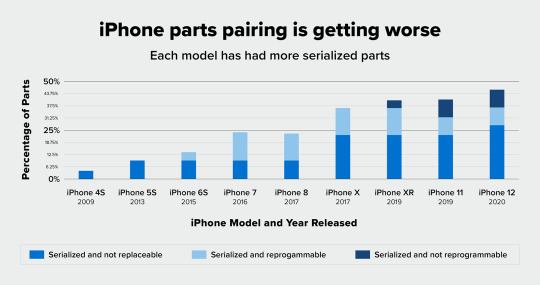
Every generation of Apple devices does more parts-pairing than the previous one, and the current models are so infested with paired parts as to be effectively unrepairable, except by Apple. It's so bad that iFixit has dropped its repairability score for the iPhone 14 from a 7 ("recommend") to a 4 (do not recommend):
https://www.ifixit.com/News/82493/we-are-retroactively-dropping-the-iphones-repairability-score-en
Parts-pairing is bullshit, and Apple are scum for using it, but they're hardly unique. Parts-pairing is at the core of the fuckery of inkjet printer companies, who use it to fence out third-party ink, so they can charge $9,600/gallon for ink that pennies to make:
https://www.eff.org/deeplinks/2020/11/ink-stained-wretches-battle-soul-digital-freedom-taking-place-inside-your-printer
Parts-pairing is also rampant in powered wheelchairs, a heavily monopolized sector whose predatory conduct is jaw-droppingly depraved:
https://uspirgedfund.org/reports/usp/stranded
But if turning phones into e-waste to eke out another billion-dollar stock buyback is indefensible, stranding people with disabilities for months at a time while they await repairs is so obviously wicked that the conscience recoils. That's why it was so great when Colorado passed the nation's first wheelchair right to repair bill last year:
https://www.eff.org/deeplinks/2022/06/when-drm-comes-your-wheelchair
California actually just passed two right to repair bills; the other one was SB-271, which mirrors Colorado's HB22-1031:
https://leginfo.legislature.ca.gov/faces/billNavClient.xhtml?bill_id=202320240SB271
This is big! It's momentum! It's a start!
But it can't be the end. When Bill Clinton signed DMCA 1201 into law 25 years ago, he loaded a gun and put it on the nation's mantlepiece and now it's Act III and we're all getting sprayed with bullets. Everything from ovens to insulin pumps, thermostats to lightbulbs, has used DMCA 1201 to limit repair, modification and improvement.
Congress needs to rid us of this scourge, to let us bring back all the benefits of interoperability. I explain how this all came to be – and what we should do about it – in my new Verso Books title, The Internet Con: How to Seize the Means of Computation.
https://www.versobooks.com/products/3035-the-internet-con


If you'd like an essay-formatted version of this post to read or share, here's a link to it on pluralistic.net, my surveillance-free, ad-free, tracker-free blog:
https://pluralistic.net/2023/09/22/vin-locking/#thought-differently

Image: Mitch Barrie (modified) https://commons.wikimedia.org/wiki/File:Daytona_Skeleton_AR-15_completed_rifle_%2817551907724%29.jpg
CC BY-SA 2.0 https://creativecommons.org/licenses/by-sa/2.0/deed.en
--
kambanji (modified) https://www.flickr.com/photos/kambanji/4135216486/
CC BY 2.0 https://creativecommons.org/licenses/by/2.0/
--
Rawpixel (modified) https://www.rawpixel.com/image/12438797/png-white-background
#pluralistic#vin locking#apple#right to repair#california#ifixit#iphones#sb244#parts pairing#serialization#dmca 1201#felony contempt of business model#ewaste#repairwashing#fuckery
1K notes
·
View notes
Text
Something I've learned about needing expensive medications is that sometimes you can go to the manufacturer's website and get a (virtual) savings card that reduces what your insurance doesn't cover to $0. Of course this isn't always available, and some manufacturers won't do it for people who are uninsured or on medicare, but it's worth looking into.
One of the medications I take is around $850 retail, and because it's a specialty (ie expensive) medication, my insurance will only cover 50%. You can get a coupon on goodRX, but that just reduces the retail price to $725. If you go to the manufacturer's website, they will cover the other half if you have a commercial insurance plan, though.
It's basically an evil little game they like to play to see how much money they can extract from your insurance before they admit that they don't need to be charging anywhere near what they are.
Paxlovid is one that you can get for free regardless of your insurance status/type of insurance, at least through the end of this year. Hopefully it'll be available again next year.
With my other $850 medication it said the savings coupon was for up to 12 months, but all that actually means is that you have to get a new card at the end of each calendar year.
The more we learn about long covid, the more strongly I feel about getting paxlovid if you can, as it's supposed to help minimize the chances of long term effects (as well as hospitalization or death).
#I mention this because I now have to get paxlovid again#womp womp#very frustrating because I STILL MASK#but at least that means I probably haven't been spreading it around
298 notes
·
View notes
Text
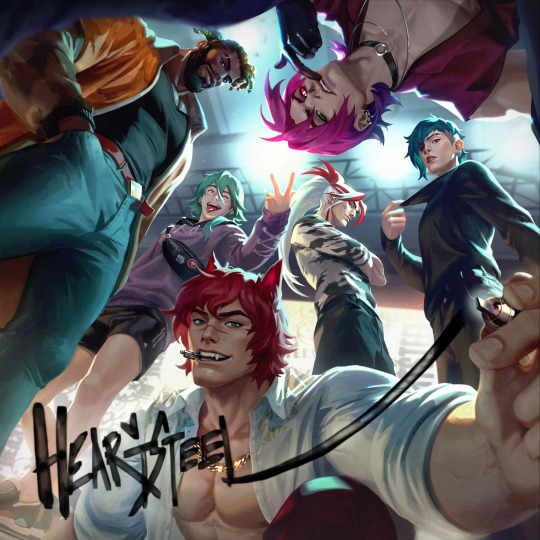

HEARTSTEEL BIO & MEMBERS
HEARTSTEEL is a virtual pop group featuring reimagined versions of League of Legends champions Kayn, Ezreal, Sett, Yone, K’Sante, and Aphelios. A group of dynamic daredevils dedicated to unapologetic individuality and bold, creative expression, HEARTSTEEL is set to blaze a path to success on their own terms after each member's failed solo careers. The group’s personality and sound draws inspiration from modern music collectives, and a range of influences from across genres and eras, culminating in a bold and fearless one-of-a-kind identity. The band’s debut single, PARANOIA, pushes the boundaries of pop music with an eclectic infusion of hip hop and electronic influences and relentless, playful energy.
SETT is the founder and co-leader of HEARTSTEEL, who started the band after being dropped from his first label. Inspired by the bold, aggressive styles of hip-hop, Sett designed the group's outfits for the PARANOIA music video and collaborated with ØZI on his rap verse.
As HEARTSTEEL’s co-leader, K'SANTE uses his talents as a singer and creative director to shape the band’s vision. In collaboration with Tobi Lou, K’Sante’s emotionally-attuned lyricism draws inspiration from R&B and hip-hop.
EZREAL first rose to stardom through a manufactured bubblegum-pop hit. As part of HEARTSTEEL, he’s found new freedom in controlling what he creates. Collaborating with BAEKHYUN of EXO, this charming vocalist takes inspiration from his fans around the world.
KAYN is a wildcard, channeling his rebellious streak through Rhaast, his onstage alter-ego. Kicked out of his former band, the multi-genre rapper and instrumentalist leans into everything new and experimental. Collaborating with Cal Scruby, Kayn pushes the envelope wherever he is.
As HEARTSTEEL’s primary instrumentalist and lyricist, APHELIOS brings a quiet genius to the band’s songwriting and composition. Though he rarely speaks, his pursuit of musical perfection guides the group. With his array of instruments (and a little help from his twin sister Alune), Aphelios aims for new creative heights.
Once a producer on international pop hits, YONE grew disillusioned with the music industry’s idea of success. Now revitalized as part of HEARTSTEEL, Yone brings an analytical focus and sharp production skills to the band. His passion for electronic music and meticulous attention to detail shapes their sound.
#sett#k'sante#ezreal#kayn#aphelios#yone#heartsteel sett#heartsteel k'sante#heartsteel ezreal#heartsteel kayn#heartsteel aphelios#heartsteel yone#heartsteel#league of legends#alune#baekhyun#tobi lou#cal scruby#øzi#league of legends skins#riot games music#league of legends music#official
688 notes
·
View notes
Text
They killed our Jesus: A Lament for Generation Jones
Two things happened in 1980 that would ensure the iron grip of the fascist state would (first slowly, then quickly), tighten on the entirety of the nation's populace from that moment forward: Ronald fucking Reagan was installed as president, and a CIA-psyop'd Christian Nationalist shot and killed John Lennon.
Those two things are connected.
First let's look at exactly who "Generation Jones" encompasses, and specific moments in the generational timeline that defined our future. The wiki page is actually quite good. Here's an excerpt that really hits it on the head:
"The name "Generation Jones" has several connotations, including a large anonymous generation, a "keeping up with the Joneses" competitiveness and the slang word "jones" or "jonesing", meaning a yearning or craving.[17][18][19] Pontell suggests that Jonesers inherited an optimistic outlook as children in the 1960s, but were then confronted with a different reality as they entered the workforce during Reaganomics and the shift from a manufacturing to a service economy, which ushered in a long period of mass unemployment. Mortgage interest rates increased to above 12 percent in the mid-eighties,[20] making it virtually impossible to buy a house on a single income. De-industrialization arrived in full force in the mid-late 1970s and 1980s; wages would be stagnant for decades, and 401Ks replaced pensions, leaving them with a certain abiding "jonesing" quality for the more prosperous days of the past.
Generation Jones is noted for coming of age after a huge swath of their older brothers and sisters in the earlier portion of the Baby Boomer population had; thus, many note that there was a paucity of resources and privileges available to them that were seemingly abundant to older Boomers. Therefore, there is a certain level of bitterness and "jonesing" for the level of doting and affluence granted to older Boomers but denied to them.[21]"
That sets the stage, for the most part. I was four when JFK was shot on TV. I was a wide-eyed, open-eared five year old when The Beatles were on Ed Sullivan and The Supremes were on the radio. I was ten when we landed on the moon, and I wanted to be a hippie at Woodstock at eleven. "Basketball Jones" came out when I was 12...I jonesed for a telescope because SPACE and got one from that great maker of fine telescopes, KMart.
Generationally, we jonesed to be ten years older, so we could have had all the cool shit THEY had. They had The Beatles, and we had the solo Beatles, they had Hendrix, Cream, Jefferson Airplane, and we had the fucking BeeGees and disco. It's like we, as a generation, were fated to live The K-Mart Knockoff of Life, instead of the bright, shiny Brand Name One all our older brothers and sisters got.
MUSIC and SCIENCE were EVERYTHING to us as kids/teens...the Eshittification Of Music truly began in 1973, and proceeded through SynthPop Hell in the '80s. Rock and Roll heroes became hairdos with guitars. The rock heroes of the '60s were getting married and having kids and baking bread. AM Radio ceased to be something you listened to for music...it began to replace music with strident, screaming hate voices that would eventually engulf all of AM Radio 24/7/365.
We were continually thwarted most of the way from our young adulthood on, blatantly from the moments in 1980 that the vile Ronald Reagan and the core operatives of evil for the next 50 years took over, and then the moment of what I call "Our Generational Wounding", the murder of John Lennon.
Back in '66, John had inflamed all the grandpas of todays magats by saying (truthfully) that with teens, The Beatles were more popular than Jesus. Beatle hate became a Very Big Thing in Bumfuck South Texas. Record burnings, merchandise burnings, book burnings, all were commonplace. A very palpable, and very specifically "Anti-Beatle" hate got instilled in a lot of kids/teens at that point, so anything to do with the Beatles was taboo for "good people" (read Southern Baptists) to like.
That, of course, made me love them that much more, and to follow their paths from their breakup forward with 'bated breath, buying every 45 they put out, trying to save pennies up to buy their albums.
John was the radical hippie, the one who wanted peace, the one with the weirdo wife, the one who held a "Bed-In" for peace. In a very fundamental-to-our-generation way, John Lennon was OUR "Jesus".
Richard Nixon (president from '68 to '74) HATED him.
In 1971, there was a true mass consciousness that incorporated us along with our older siblings, a musical mass consciousness. I became aware of many things in 1969, specifically fall of '69, so I was experiencing all this in real-time, as it happened. When the news that The Beatles officially broke up came across the AM radiowaves in May of '70, it was A. Very. Big. Deal. Everyone watched everything they did from that point on with GREAT interest.
George put out "My Sweet Lord" and "What Is Life" (first record I ever bought), John put out "Instant Karma", "Mother", then "Power To The People", then "Imagine". Ringo put out "It Don't Come Easy", and Paul & Linda had "Uncle Albert/Admiral Halsey". EVERYBODY was a "post-breakup Beatle critic", panning Paul's very first solo 45 "Another Day", "Uncle Albert" was the followup. This band called Badfinger that sounded suspiciously like The Beatles appeared on American radio, and would make 1972 one of the final "Golden Years" of AM Rock Radio.
In 1970 we heard about this Elton John guy, by the end of '72, I was playing as many of his songs on the piano as I could figure out. My favorite album was (still is) "Madman Across The Water". When "Goodbye Yellow Brick Road" came out in '73, a very noticeable shift was occuring.
Pop became much less political. It softened. It mellowed. It grew its hair long and lived in the country, learned how to grow potatoes and play the mandolin, making Country Rock the one lasting "legacy" of our sad sub-generation. By the time I graduated HS in May of '77, it was all there was on the radio, besides....disco. Oof.
One of my first TV memories was JFK getting shot. That was the Generational Wounding of our older brothers and sisters. When Mark Chapman (a Christian nationalist who changed the words of "Imagine" to "Imagine there's no John Lennon") shot John in December of 1980, it was the 2 in the 1-2 PUNCH done to our OUR generation. The first, of course, being the installing of Reagan and the evil Evangelical influence beginning in earnest.
It also began the buildup of the "Holy War" radical right, and an utter denial and clampdown of "hippie", of "counterculture" in general began, ensuring that John's vision of world peace would never come true, at least not on their watch. They had, effectively, killed OUR Jesus, along with our chances of the kind of security our older sibs got in spades. It also marked the unholy marriage of the evangelicals and the republican apparatus.
When Reagan got elected by virtue of the vile Newt Gingrich's 'Southern Strategy', a clampdown in earnest on the very SPIRITUAL EXISTENCE of our generation's incredible want and need, our collective JONESING for world peace began. Richard Nixon had planted the seeds. Nixon hated John Lennon with a passion. After Reagan was elected, I firmly believe Chapman was "activated" and they killed John as a Christmas present to Nixon.
It was after that, when the dream of a scientific future began to die, as well. When we were in high school, SCIENCE WAS EVERYTHING, so we wanted to be some kind of scientist "when we grew up".
I dealt with four years of college, majored in Biology, and in early 1981 realized my dream of being a Forest Ranger in Yosemite or some other national park somewhere, living in a cabin, giving talks to visitors about the biology aspects of the park....all that went POOF, almost instantaneously. My degree would get me nowhere, so I left before the end of that year and started working in record stores.
I was effectively the Cusack character in the movie about record stores, but it led to a dead end. Record stores weren't all that glamorous, and yes, the pay was dogshit. I tried working in record stores for the love of the music, while trying to BE a musician in a town FILLED OVER FLOWING with musicians, but that was quickly shat on by the beginning shrieks of late-stage capitalism.
It was like working in the record stores was my trying to keep holding onto the dream, our generation's dream...John's dream of world peace (along with my dream of being a working musician) died a pitiful death by the end of 1986.
What followed was nothing but a series of Jobs I Hated, and the beginnings of the true Jonesing for the life we'd been promised, because we didn't get the raises, the pensions, the house, the car, boat and camper, none of that shit for us. A life of being a low-paid, no-insurance drub, destined to be a life-long renter, unless a financial miracle happens.
So when people ask why we (as a generation) hate Ronald Reagan so much, let's just say I'm with Bugs on this one.
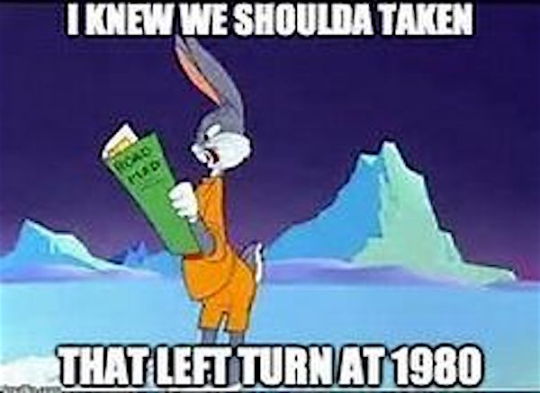
253 notes
·
View notes
Note
Hmmm, had an idea I wanted share with you.
What if the Aeons in this AU are these super advanced A.I.s that the corporations responsible for manufacturing the Androids have as responsible for creating and programming them. And sometimes, due to one reason or another (their programs reaching a point where they can't he updated any further, or it starting to decay or corrupt. Not quite sure how to put it, I'm not overly computer savvy) they sometimes need to be replaced.
Like for example, Penacony Entertainment Firm's (the corporation responsible for Robin's creation) original design A.I. was Ena, but was later replaced by Xipe (but Ena's program was considered "too important" to simply throw away, so they Xipe simply absorb their Order programming into their Harmory algorithm). Yaoshi was originally the Xianzhou Militech Corporation's lead A.I. but the way their program was developing was considered "too dangerous" and so they planned to replace them with Lan. But Yaoshi has seemingly developed to the point where they were self-aware, and went rogue, resulting in the creation of a virus called "the Mara" which they would proceed to start infecting androids made Xianzhou (as well as other companies they could dig their virtual roots into). Their first victim being Android! Jingliu.
Jingliu was originally a combat android, before the Mara corrupted her personality core, leading to instances of her attacking friendlies, eventually being sent to you to be terminated after she ended up deleting the last person she had been serving under. But you just can't bring it upon yourself to pull the plug on her, so instead you attempt to help, trying to keep her under control while trying to find a way to purge the Mara from her programming. And it's through this time that Jingliu finds herself growing quite interested in you. It turns out the Mara's effects on her personality core also inspires her to actions of a more lewd variety 🤭
This is actually a really clever way of implementing the Aeons into the Android AU and still making them very powerful beings 😳
I’m so impressed! I would like to make this canon in the lore because it’s so smart. Also the fact that Jingliu’s Marastruck virus affects her personality core and in turn makes her horny, is really amusing to see. Imagine this stoic, seemingly emotionless combat Android wanting to touch you and attach mechanical genitals to her body like a Sex Android, suddenly taking an interest in things like sex, feelings, etc. and wanting to be close to you at all times.
You’d be so confused as to why Jingliu was suddenly getting “grabby feely” with you and getting frustrated because she can’t feel any pleasure. But since it was clear she was uncomfortable and needed something down there to satiate herself, you decided it would be harmless to attach a mechanical penis to her. What harm could that do? She’s probably just gonna masturbate—
Well, Jingliu wasn’t so harmless anymore. Now that she could experience proper pleasure in her nether regions, she was intent on making you the source of her pleasure. Not like you wouldn’t reject her, ofc. You’d gladly help out an Android if they were in a time of need 🤭
86 notes
·
View notes
Note
okay so i’ve never really grasped this, might as well ask now — how exactly does the cyberspace & nft stuff mine resources? i’ve heard the basics (i.e. crypto mining uses energy and what not) but i’ve never been able to understand how internet connects to real resources. could you sort of explain that (along the lines with the spam email post) in a simpler way?
ok, put very simply: it's easy for people who only interact with the internet as users to treat 'cyberspace' or 'the virtual world' as immaterial. i type something out on my phone, it lives in the screen. intuitively, it feels less real and physical than writing the same words down on a piece of paper with a pencil. this is an illusion. the internet is real and physical; digital technology is not an escape from the use of natural resources to create products. my phone, its charger, the data storage facility, a laptop: all of these things are physical objects. the internet does not exist without computers; it is a network of networks that requires real, physical devices and cables in order to store, transmit, and access all of the data we use every time we load a webpage or save a text document.

this is one of google's data centres—part of the physical network of servers and cables that google operates. these are real objects made of real materials that need to be obtained through labour and then manufactured into these products through labour. the more data we use, the more capacity the physical network must have. google operates dozens of these data centres and potentially millions of servers (there is no official number). running these facilities takes electricity, cooling technologies (servers get hot), and more human labour. now think about how many other companies exist that store or transmit data. this entire network exists physically.
when you look at a server, or a phone, or a laptop, you might be glossing over a very simple truth that many of us train ourselves not to see: these objects themselves are made of materials that have supply chains! for example, cobalt, used in (among other things) lithium-ion batteries, has a notoriously brutal supply chain relying on horrific mining practices (including child labour), particularly in the congo. lithium mining, too, is known to have a massive environmental toll; the list goes on. dangerous and exploitative working conditions, as well as the environmental costs of resource extraction, are primarily and immediately borne by those who are already most brutally oppressed under capitalism: poor workers in the global south, indigenous people, &c. this is imperialism in action. digital technologies cannot exist without resources, and tech companies (like all capitalist firms!) are profitable because they exploit labour.
all commodities require resources and labour to make and distribute. digital technology is no different. these are material objects with material histories and contexts. nothing about the internet is immaterial, from the electromagnetic waves of wi-fi communication to the devices we use to scroll tumblr. it is, in fact, only by a fantastical sleight-of-hand that we can look at and interact with these objects and still consider the internet to be anything but real resources.
393 notes
·
View notes
Text
For Thresholder there are lots and lots of worlds, most of them just name-checked, sketched out in a handful of paragraphs as a place that people had visited before and now has little plot relevance. It's my favorite part of the series.
I'm not writing one of those chapters where I need one of those worlds, and I'm not sure I could give this one its due, but the idea I had last night was a world where people could increase and decrease the size of objects virtually at will. This doesn't work with conventional physics, but that's okay, some of the worlds can be more conceptual.
To start with, we have some ground rules: you have to be touching the thing, it can only operate on loosely defined "whole objects", and there's some kind of thing that happens with objects where they retain their physical structure to some degree, even if the square-cube law means that not everything stays functional. This is easy for things made of base elements (an iron nail becomes bigger and we can grok that it's still just made of regular iron) but it's less easy for complex organics. If you increase the size of an apple, are the individual cells increasing in size? Are new cells being generated? I think for this, I would have to say that the answer is that the world works on a level of pre-Enlightenment human understanding that the real world doesn't have, one where there aren't cells. (I am a bit sketchy on when cells were discovered, and more sketchy on what they thought was going on before that.)
As far as consequences, which is my favorite thing, I think there are a few big ones.
For one, any amount of food is enough to feed an infinite number of people. A single apple can feed a family, if they want to have nothing but apple for a meal. A single apple slice can feed a family. In fact, even the smallest crumb can undergo the process of magnification to become a full meal. But while you can make "more food" by making it bigger, the taste and texture don't necessarily stay the same. It seems to me that there's probably a sweet spot for most foods in terms of size, and eating a grain of rice the size of a loaf of bread is a very different experience than eating a bowl of rice. And if you've ever eaten one of those sourdough breads with way too large of bubbles, that's what pretty much all bread would look like if magnified, just holes with strands of gluten between them. So I think in terms of food, there would be a lot of class divide, along with a lot of processing of magnified foods to make them more palatable. Maybe a loaf-size grain of rice wouldn't appeal to many people, but you can break off bits of it and probably still make mochi with it.
Another big issue is manufacturing and the trades. In my mind, you have construction workers building the equivalent of dollhouses that then get sized up on a plot of land, but I think dollhouses are a little bit small, and most trades would work on a scale that was easiest for human manipulation. I don't think that's what we do for dolls, which tends to be nimble, finnicky work, and if you can freely scale up and scale down your tools and materials, I think you'd naturally want to work a bit bigger. Probably you would rescale on many different steps of whatever you're producing, and if this world was in the industrial age, then you would have people in factories rescaling as a human step in a factory somewhere. Another cool thing is that a chef could have a single pot and pan that they resize for their needs, and a single knife that fulfills roles we would use two or three different knifes for, though I think maybe handles would be a problem there.
Anyway, I'm not going to use this anywhere, though I do think it's cool, if maybe in a way that's not all that unique (What if Big Thing were Little Thing and What if Little Thing were Big Thing are both speculative fiction staples, see Indian in the Cupboard, The Borrowers, Ant-man, etc.). I have a bunch of outstanding questions re: conservation of momentum and some hacks that only work under certain implementations, but sometimes that's a bridge too far.
72 notes
·
View notes
Text
Business Guide:
How to get started
When you have a business name in mind look up the domain name to see if it’s taken. You don’t want to spend money on an LLC just to find out that your name is taken. Thats a waste of money because you also have to pay to dissolve it.
If the name is not taken, great, don’t file an LLC yet. Go online and get a virtual business address. Why? If you’re running your business out of your home like I am, just know that it’s public information if you use your address to file your LLC. A virtual address should cost like $10-$20 a month. Use that to file your LLC.
Once you’ve filed that LLC get your Ein. That’s your Employee Identification Number. It’s your businesses tax id. It’s free to file on the IRS website. Don’t fall for the scam websites you guys.
Once you’ve gotten your EIN go to Google domains and get your website name aswell as 3-4 emails. An email for your social media accounts, an executive email for yourself, an [email protected] for things like your business bank account, Shopify account, etc; and maybe a customer support email. I use the social email as a customer support email. All of this should be like $50/month.
Once you’ve don’t that get on Canva and make that logo bookie. Personally I paid someone on Fiverr to make mine because I’m a “soft business life” kind of girl and I’d rather pay the professionals. Thats just me though.
Once you’ve got your logo go ahead and get them social media accounts going. Instagram, tiktok, Facebook.
Alright now this is where it gets specific to clothing brands because that’s what I own.
Time to find a manufacturer. Head over to alibaba and search what kind of product you want to sell. Be sure to add “oem” if you want a manufacturer that customizes. Look for the amount of orders they’ve gotten on that product. If it says zero orders that’s ok. Some styles are new and thus haven’t been ordered yet. Check any reviews they have for other products. Also check the total revenue they’ve done. It’s on the store profile. I can’t tell you what the sweet spot is yet bc I’ve only used one manufacturer so far but I’d look for mid six figures and up if you wanna be real safe.
Chat with them and order a sample. Even if you buy from a vendor list you’ll need your own sample to make content with. I suggest buying one and first. It’s worth the wait because if you buy multiple and end up not liking them you’d have wasted money that could’ve gone into testing a different manufacturer.
Do not launch with more than 2 products. Even 2 is a stretch, wallai start with one.
This is because if you’re doing the preorder, which I suggest, you’ll be depending on customer orders to pay for the bulk order. Manufacturers do their moq by color or style. If you have too many options in your website and customers order a mix of things, you better pray you have enough money to cover the bulk for all those different styles. Stay safe and give them 1-2 options to choose from.
Pre order method is great if you don’t have a lot of cash to start with because the orders pay for themselves. Bulk orders start to wrack up. Especially if it’s a custom style or material. You don’t want to break the bank for something that might not sell.
Once you’ve gotten and approved your samples choose a launch date. 2-3 weeks before that launch dates post consistently. At least once a day but remember quality over quantity. Now don’t be tricked. Quality doesn’t mean a full cinematography. It means connecting with your audience and relating with them to a point where they’re like “this business gets it”. Either that or attaching yourself to an identity they want to have. “It girl ig influencer”, “feminine soft life babe” “clean girl Pilates princess” whatever the fuck it is embody ur as best as you can. When customers attach your product with an identity that is aspirational to them they will buy it without rationalizing. It’s why the luxury market makes so much off of ppl who can’t afford to buy it twice.
Focus on the backend
If you have a goal of getting an influx of orders and making a lot of sales, be sure that your business is structured in a way that can handle it happening at any given time. You know those tiktok businesses that get one viral video and sell out over night? That could be you but if you’re not prepared ppl are going to be upset. I suggest working backwards:
A customer service platform/inbox so that you can answer them right away with frequently asked questions.
Have stock so that you have something for customers to buy once they finally land on your website.
Have a well presenting website so that ppl don’t think you’re a scam. I’m going to do a post on this bc some of these business websites drive me fuckin nuts. Color theory ppl, color theory.
A social media page with some kind of social proof ie reviews from customers in some way shape or form. Ppl are going to be looking for what others have to say about your brand. Hire UGC creators to make videos that you can post on your page. They’re cheaper than influencers but still know how to convey the message well. You’ll have to have extra samples and items on hand to send them. Also check out their usage rights. Some will allow you to use their videos in ads but you have to pay extra and it’s only for a certain amount of time. But if they do it right, you’ll get a great return. Scared money don’t make no money.
A social media page that shows the products in movement and different lighting. I need to be able to imagine myself in the item before I buy it. Where would I wear it, how will it fit on me. Even when I’ve already ordered something I stay going back to the businesses social media page just to see the clothes again. I might even search it up to see other ppl wearing it.
Packaging
No need to go crazy with the packaging in the beginning. Don’t get me wrong, branding is important but as a beginner you may not have the money for that yet. You need to focus on spending money on what will give you the best return. Just get regular poly mailers from Amazon in your brand colors. You’ll also need:
A stack of 6x4 shipping labels
A thermal printer
A scale
When your manufacturer sends you the clothes they will most likely be in their own little bags. If not you can get those from Amazon too.
Later on you can go to alibaba and find a manufacturer to print you custom poly mailers for that extra edge. Put your logo, a cute message, and your social media handles on the bag and that’s it. Good to go.
You can also design your own thank you cards as well. I won’t be doing that.
Little things to remember
Don’t feel like you have to keep up with big brands. You don’t need to launch something every two weeks. As a matter of fact I advise against emulating super fast fashion brands. I only launch a new item once the pre ordered items have been shipped out to customers.
Be nice to your customers. You’d think this was obvious but it’s not. Some ppl are rude, ghetto, and uncouth. If you hate authority and have a smart mouth I think you should either take a customer service course or hire a virtual assistant from the Philippines to do your customer service for you because no customers = no money.
I’ll update this as I learn and grow:
12/18/2023
Influencers
Not every influencer with a mass follower base is going to be your influencer. It’s possible that you pay $5000 for an influencer with 75k followers to post your product on her page but that post makes you less than $3k. That means you’ve net negative $2k. What a fuckin waste of money.
This is why it’s important to develop a persona for your brand. What is your brand identity? Who is your target audience? What are their psychographics?
Where do currently shop? What are there favorite social media apps?What is their race? Their age? Their ethnicity? Are they in college or highschool? Do they have parents that support their lifestyle or are they hustlers? Are they concerned about price or quality more? Are they married? Do they have children? Are they environmentally conscious?
You need to embody Joe Goldberg and peer at them through their window. Acquaint yourself with every part of their life.
Also, you might not be your target demographic yet and that’s ok. The girls that shop with my brand have social lives. They go out with their friends and need outfits to wear. I don’t have a social life. The only clothes I wear are my work clothes to go to work and my robe when I’m at home.Or a sweat set and a bonnet to run errands.
Don’t think to yourself “ I would never wear that.” “I would never buy something at that price point”. That’s fine cuz someone else will. A lot of people will.
Another thing is your demographic could change once you start your business. It might be that you create content that attracts a different type of person than what you originally planned and that’s cool too. We don’t live in a perfect world. As long as they’re close enough to what you had predetermined it’s ok. Sometimes our business comes out different than we hoped but it’s just as good if not better. It’s like child. Don’t destroy its greatness trying to turn it into something it doesn’t want to be.
User generated content
Love, love, love her down. She’s that sweet spot between making content yourself and having an influencer with a large following make the content for you. UGC is a form of social proof which is something you need for an e-commerce brand especially. Ppl can’t just pop into your store and try on your stuff so they need the opinions of “regular” people to sell them on it. They want to see that person try it on, do a close up of the fabric, wear it to a social setting, etc;
What I like about UGC is that I can pick someone who fits into my brand persona to represent my brand even if I don’t. Someone that appears aspirational but still relatable. Like I said previously, you yourself might not embody your brands persona but you can pay someone who does.
A little translate for yall: I do not live in a nice apartment. My room is small, and dark, and filled with boxes. My living room has mix matched decor and I myself am not the body type I’d like to be (pls don’t hit me with body positivity babe). What I can do is pay a girl with the opposite of all those things and knows how to sell a product.
I have a girl right now that I’ve inquired to make posts for me and she’s got it all. Her rate for one video is $100 with an extra $30 for 90 days of usage in ads. $100 is the new 50 and for the return I’ll get on her, THATS A STEAL.
If you need to find a UGC creator search it up on tiktok and Twitter. Most of them have a portfolio of past work they’ve done. If you feel like they match your brands vibes, keep their info for when you’re ready.
I suggest to have a roster of them because if ppl keep seeing the same person over and over, the thought that that person is just a regular degular customer leaves their mind and you lose the magic of UGC.
Update 12/21/2023
I’ve been sick but yall ain’t paying me so it’s ok. Here’s the update.
Website
Your website is your home babe and when you’re preparing for guest you can’t have your home looking any type of way. Not only does it need to be clean but it needs to be cohesive and inviting.
You know how many times I’ve opened someone’s booking page on Instagram and I click off. Not only am I not reading through all of that small ass text but my head hurts cuz you’ve got a black font on a hot pink background.
Some of yalls websites to not comply with accessibility guidelines so pay attention to that bc you can be sued. Ppl should be able to read what you have on there without getting a headache.
Good rule of thumb is to have one primary color, and then black and white. Don’t over complicate it. Your primary color will be your logo, think twitters blue, then your secondary colors should be black and white, for your text. You might have an accent color like gold or silver, this should be used sparingly for a little dazzle.
If you’re a clothing brand like me, keep the text short and sweet. Think about it, when you go shopping on your favorite website are you bombarded with a soliloquy on how the collection came to be? And even if you are do you stop and read the whole thing? I don’t bc I don’t care. That’s what your Instagram story is for.
All I want to see is the attention grabber and a short,but convincing, tagline.
Example: Ski Resort 2023-“Stun the slopes and stand out on the ski lift with best sellers spotted at St. Moritz”
Let you images tell the rest of the story.
Don’t overwhelm them with options
Guys this is so important. The more options ppl see the less they buy or the less likely they are to buy. Why? This is the thought process.
“Omg the stuff on this website is so cute! Let me go through their catalog and add to my cart as I go”
5 minutes of scrolling
“Ok I have too many things in my cart let me just save to a wishlist instead”
Another 5 minutes of scrolling
“Ok I’ll just stop here and go back to my cart and decide what I’m going to get rn”
Goes to cart
Spends 10 minutes deciding what she’s gonna get bc there’s so many good options
Takes 10 items out of her cart and only buys two basics bc she knows those are less likely to disappoint.
And scene
That is if she didn’t leave after the second five minutes of scrolling. Nowadays five minutes on a non stimulating website is a lot, don’t let it take that long.
Obviously this also depends on the customers budget. Some people have the money to just buy everything in their cart (I wish- one day), but most are just window shopper you hope to convert with your nice styles, images, and prices. Don’t make it harder for people to give you their money.
I have more but I’m tired of writing so I’ll update yall tmrw.
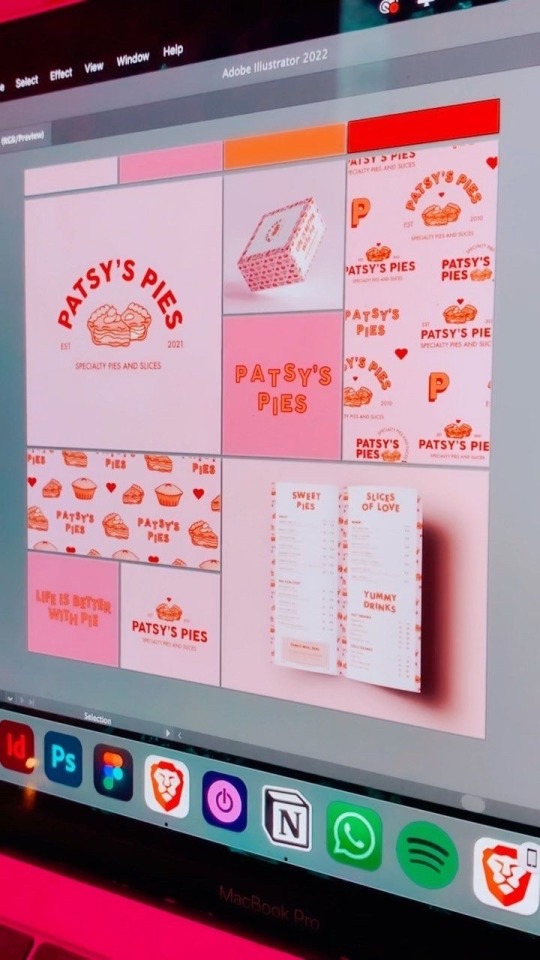

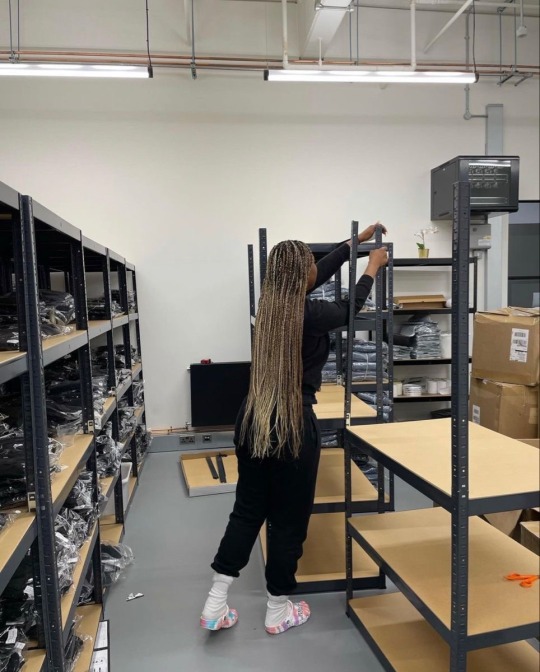
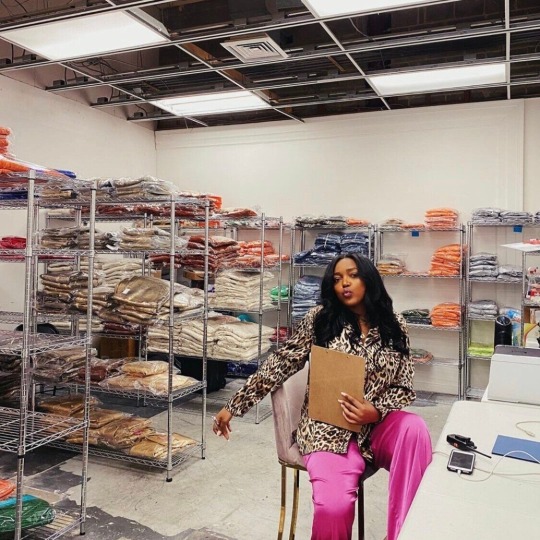
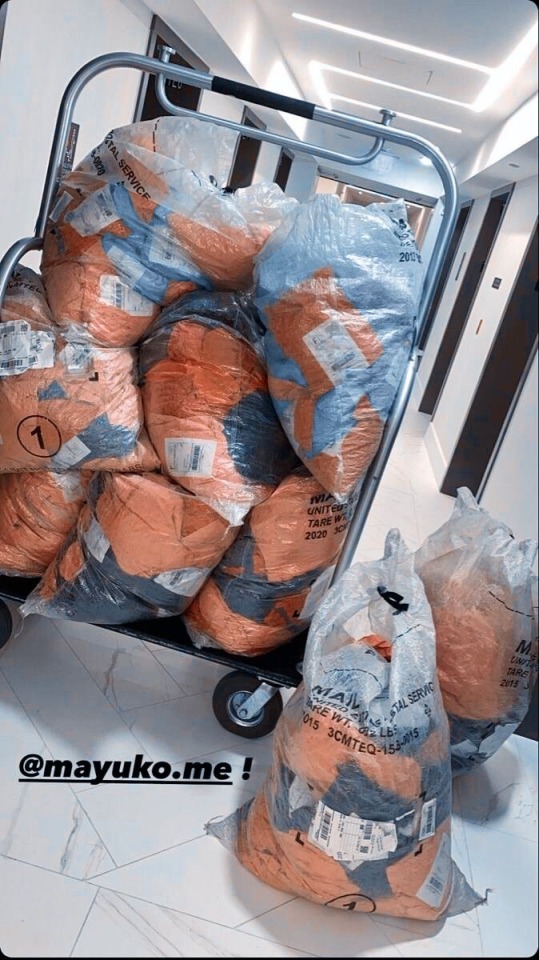
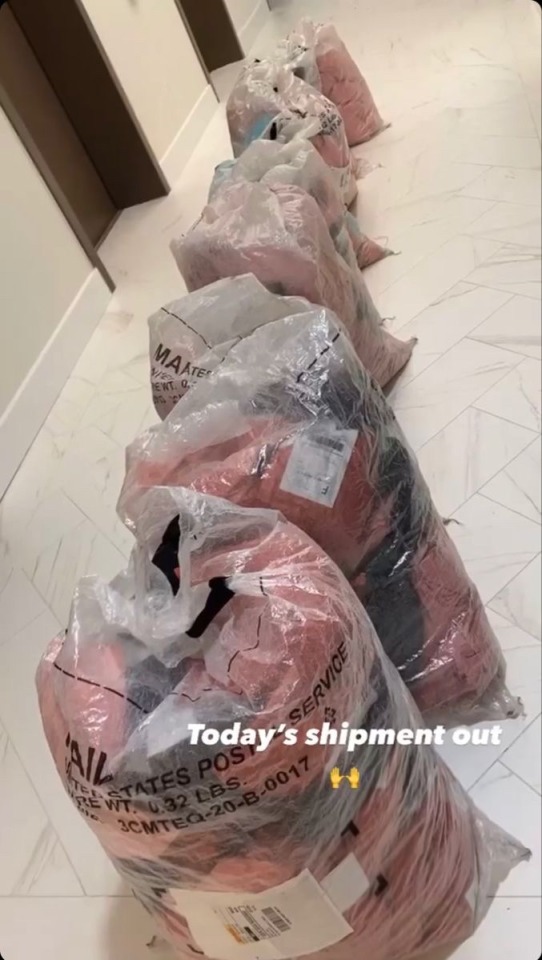
#level up#glow up#luxury#entrepreneur#spoiled heaux#blackgirlglowup#scaling business owner#confessions of a business owner
154 notes
·
View notes
Text
What is virtual manufacturing ?
Virtual Manufacturing refers to the use of computer-based simulation, modeling, and visualization techniques to design, analyze, and optimize manufacturing processes and products before they are physically created. It integrates virtual reality (VR), augmented reality (AR), and advanced computer-aided design (CAD) systems to simulate real-world manufacturing operations in a digital environment.
Key Components of Virtual Manufacturing:
Simulation of Processes: Mimicking real-world manufacturing processes, such as machining, assembly, and quality control.
Digital Twin Technology: Creating a digital replica of physical systems to monitor and optimize production.
3D Modeling and Visualization: Using CAD and VR tools to visualize products and processes in 3D.
Process Planning: Testing and improving production workflows virtually before implementation.
Ergonomics and Safety Analysis: Simulating worker interactions with machinery to ensure safety and efficiency.
Applications of Virtual Manufacturing:
Product Design: Testing prototypes virtually to reduce costs and development time.
Factory Layout Planning: Designing optimal layouts for equipment and workflow.
Training: Immersive VR training environments for operators and technicians.
Predictive Maintenance: Simulating wear and tear to predict equipment failure and plan maintenance.
Quality Assurance: Virtual inspections to detect and resolve defects early.
Benefits of Virtual Manufacturing:
Cost Efficiency: Reduces physical prototyping and trial runs.
Time Savings: Speeds up product development and manufacturing cycles.
Improved Quality: Allows for early detection of design and process flaws.
Flexibility: Easy to modify and test multiple scenarios.
Sustainability: Minimizes material waste and energy usage during development.
0 notes
Text
The mystery of P's skin
If there's one thing the entire Lies of P community can agree upon, it's probably that Pinocchio looks very, very handsome. Many people - including me - were enamored by his looks from the moment they first saw him in the trailers, by his soft locks, sweet freckles and big blue eyes.
However, even early on, I couldn't help but feel like there was something... odd about his features - more specifically, his skin. For a puppet whose outer shell usually consists of porcelain, wood, or some other artificial material, it looked almost too realistic.
Of course, it could just be very realistic looking faux skin (which, given Lies of P's 19th-century technology, would be kind of impressive), but after some careful observations, I get the feeling there actually might be more to it. And given some of the things I learned in my research about real-life automata, there might be a grisly, sinister secret behind P's innocent face.
[Massive spoilers for Lies of P]
[CW: skinning, violence to children]
The Lies of P character cards
The first time I noticed there was something strange about P's skin was when I was looking at the character cards Neowiz released back in 2022, as promotional material for Gamescom.
These cards feature high-resolution renders of the main characters, showing a lot of structural details of clothing, hair, and skin.
As for P's render, it looks like this:

One thing that confused me from the start was just how perfectly normal his skin looks. Most of the other puppets have porcelain skin, which creates a very distinct reflection when light falls onto it, as we can see with Polendina:

For P, however, we see no such effect, implying that his outer shell is not made of porcelain. Also, seeing how he occasionally squints his eyes on the character screen and how his skin squishes and stretches as a result, I think it most definitely consists of something else - because if I know one thing, it's that porcelain does not physically behave that way.
Instead, a lot of people (particularly fanfic writers) have come up with the headcanon that P has really realistic-looking faux skin. However, if that were the case, I would find it really puzzling just how many small impurities there are on his face. You would probably expect synthetically manufactured skin to look very smooth and clean, but in case of P, if you pay close attention, you can spot tiny irregularities giving the impression of skin pores, and even a bump above his left eye.
In comparison, P's skin actually looks surprisingly similar to that of the human characters from the game. For reference, here are the portraits of Sophia, Venigni and Eugénie:



See what I mean? There is virtually no distinction between the structure of P's skin and that of the human characters (to be fair, Eugénie's even looks a lot cleaner). Adding to this, these close-ups of P's face during the ending cutscene make it apparent that these small blemishes certainly, most definitely are skin pores.
Considering all of this, I've come up with a somewhat eccentric theory - that P's skin is neither made from porcelain nor some other kind of faux material, but real, actual skin.
Automata with animal skin and Vaucanson's "Flute Player"
Some of you may wonder: "But P is a puppet! How could he possibly have real, human skin?"
Well... this is where the disturbing part begins.
First off, we have to take a quick dive into the history of automata, the real-life clockwork machines providing the basis of Lies of P's lore. Originally, clockwork mechanisms took up an enormous amount of space, being used for huge clock towers in cities and large-scale moving sculptures. Over the centuries, the mechanical components became smaller, enabling clockmakers and artisans to produce more intricate crafts, including miniature reproductions of people and animals.
Clocks and music boxes featuring birds with real feathers were extremely popular, but there were also other automata coated with real animal skin: As early as the 17th century, we have a drumming bear with actual bear fur (located in the Mathematisch-Physikalischer Salon, Dresden) and a pair of lion table clocks (located in Skokloster Castle, Sweden) coated in the hide of lambs. From the 19th century, we know of a toy mouse by Gustave Vichy as well as a toy rabbit by Nicolas Théroude, both covered in real animal fur. In addition, there were various 19th-century dolls with leather bodies, and the company Jérôme Thibouville-Lamy even produced a miniature ensemble of monkey musicians with heads covered in soft leather, which could move their lips to show their teeth.
However, we don't have any accounts that skin was used for human automata - except for one extraordinary case from the 18th century.
In 1738, the French inventor Jacques de Vaucanson presented an automaton called "The Flute Player". It was the size of a real-life human, and in contrast to all other automata of the time, it didn't use some kind of sound box to produce its music, but actual air flow. The inner mechanism consisted of a system of nine bellows, divided into sets of three, which were each controlled by a weight to regulate air pressure. Each set was attached to a pipe, three in total, which all joined up into a single one, similar to a trachea. This singular pipe continued up the throat, widening at the top to form the mouth cavity where the air flowed out. To correctly play the flute, the automaton was equipped with lips which could not only open and close, but also move back and forward to cover the holes. To better control the air flow and create pauses between notes, the automaton even possessed a movable, silver tongue.
Despite this virtually perfect imitation of the action of flute playing, Vaucanson had to realize that the automaton's metal fingers weren't pliable enough to cover the holes of the instrument correctly - so, for the automaton to be able to execute its task, Vaucanson had to glove the hands in real, actual skin.
It's speculated it was human skin, although I couldn't find any source decisively confirming this. Either way, despite Vaucanson being a quite controversial figure among his contemporaries, he was a fascinating personality: He was one of the first to construct automata that were not meant to serve as mere toys, but which could do labor, being credited with the invention of what we today would call household androids back in 1727(!), and chances are he was neurodivergent as well (coming from my own observations as a neurodivergent person).
However, as much as I'd love to write an entire essay about Vaucanson right now, let's get back to our actual topic.
The procedure
To put it bluntly, what I think actually happened is this:
Geppetto took the skin of a dead boy, treated it in some way so it wouldn't rot, and then draped the skin over a wooden puppet frame.
I think from a moral standpoint, Geppetto would definitely be able to do this - however, it would require him to have a good deal of experience with human anatomy. As someone who builds humanoid puppets, I think he would at least have a theoretical understanding of it, but still, he's an engineer, not a doctor.
There is, however, one group with excellent medical knowledge who certainly wouldn't shy away from dissecting a human being: the Alchemists. Although Geppetto's dislike of the Alchemists is well known, he himself admitted that "in desperate times, I broke my own rule" after the disaster at the Grand Exhibition, and I assume Carlo's resurrection would be more than good a reason for that as well. Basically, my suspicion is that Geppetto had help from the Alchemists - maybe even from Simon Manus himself. If this was the case, I imagine Simon probably demanded some kind of favor in return - perhaps Geppetto and Simon struck a deal, with the Alchemists giving Geppetto free rein to execute his little experiment with the Puppet Frenzy, while he agreed not to interfere with their own. This would support the Mad Donkey's statement that Geppetto and the Alchemists were "scheming together". (Also, if they were actually working together, I think things already started with the Nameless Puppet, Geppetto's first attempt at resurrecting Carlo. In the cutscene before the fight against the Nameless Puppet, we can see that Geppetto's left hand has been fitted with implants, having the same bluish complexion that is typical of people who have been "enhanced" by the Alchemists.) However, I don't think Geppetto ever really trusted the Alchemists, so he probably planned to betray them at some point - at the same time, I think Simon knew Geppetto was deceiving him (reading thoughts is such an op skill), so he didn't fully rely on him either.
Regardless whether Geppetto had assistance or not, completely skinning a human without damaging the skin requires an immense amount of care. Looking at P's skin (or at least what we can see of it), there are no visible seams anywhere, which would mean Geppetto did his best to keep it intact, probably including the hair as well. (As we all know, P's hair looks very soft and natural, and you can't see any outlines where it was glued on; therefore, I believe it was left rooted in the skin.) Nevertheless, if you want to skin a body, you have to make a cut somewhere. One possible option would be the hole in P's chest (where the P-Organ is inserted), as there would later be an opening anyway; also, given that the Legion Arm would later replace the left one, there would naturally have to be a cut at the left upper arm. However, both of these openings would most likely be too small to completely remove the skin. Due to this, my suspicion is that Geppetto made a third, larger cut down P's back. It would be big enough to take the complete skin off, and it would also be convenient if P had something like a cam storage in his back, similar to the Jaquet-Droz automata. (This has been a headcanon of mine for a long time, since these cam discs act as an analogue storage for a clockwork automaton's movements, which are engraved into the edge. Given that P's combat moves are quite complex, he'd need a lot of space for those; btw, my theory is that the amulets from the game are actually interchangeable cams, because they have "information and memories that are useful for movement" imprinted on them.) I would assume both the openings at the front and at the back are usually covered with skin, with a small seam being visible where the original cut was. Whenever Geppetto needs to do maintenance, the skin would be peeled back to give him free access.
As for the rest of the process, I suppose it would be kind of similar to taxidermy. As it happens, the Victorian era (which is around the same time period the game is set in) was actually the golden age of taxidermy, when mounted animals started to become more lifelike - there was even a trend among pet owners to let their deceased pets be stuffed, as a way to "resurrect" them. (Just why do I always manage to stumble upon the most cursed parallels?) Once the skin had been taken off, any remains of fat and muscle tissue would be removed, after which it would be either tanned or treated with preserving chemicals. Following this, the skin would be mounted on a mannequin, in P's case probably a standard puppet frame made from wood and metal. Of course, you need to take precise measurements of the original body beforehand, and since this is about his darling son, I imagine Geppetto would put extra care into the modeling. At the end, all you'd have to do is add glass eyes - and well, there you have it: a perfect, biomechanical imitation of a human being.
However, we do know there were some unexpected changes in P, even physical ones like his hair growing. Presuming that he indeed does have real skin, I wonder if this may be due to the Ergo "recognizing" the organic material in some way, causing these lifelike reactions. I could imagine a puppet with human skin is quite unprecedented, so this would likely be a first time occurrence - in that case, it might potentially give a whole new meaning to Sophia's statement that P is a "special puppet". (I could go into even more detail regarding my theories about Ergo and P's transformation into "another kind of human" here, but frankly, I think this topic deserves its own post.)
I think P is far from Geppetto's first attempt, however: We do know from the description of the Nameless Puppet's Ergo that the Nameless Puppet (which presumably is a Frankenstein version of Carlo) was the first to be equipped with a P-Organ, but after it turned out to be unstable, it was left abandoned and locked away. In that sense, I imagine Romeo was something like a "field test" - I don't think turning Romeo into a puppet was something Geppetto planned from the start, but when he came and asked him, he presented Geppetto with too good of an opportunity to pass up. When the transferring of Romeo into his puppet body, all memories and personality intact, turned out to be a success, Geppetto decided to take the next step with P. I assume he designed multiple versions of P until he was satisfied, which might mean that the broken puppet in the swamp (which also seems to possess a P-Organ and isn't bound to the Grand Covenant) is actually one of P's predecessors.
Still, as interesting and disturbing all of these speculations are, there is one question that remains: If P really does possess real human skin, who was the original owner of it?
The origin of P's skin
The first, most logical assumption would probably be that Geppetto used the skin of Carlo. Back in 2022, when everyone hypothesized Geppetto had a son but no one could confirm it, I also assumed he took the skin of his deceased son.
Now that we know the game's story though, we have a bit more information. First off, it's heavily implied that the Nameless Puppet is actually a Frankenstein version of Carlo, which would mean that the weird organic-looking parts - specifically the upper body, right arm and face - originally belonged to Carlo's body.

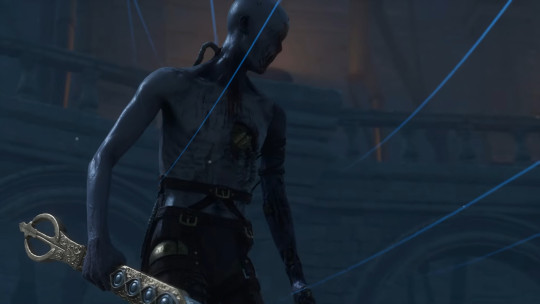
Given that they have the appearance of decaying tissue, it seems like Geppetto did his best to save as much of Carlo's body at first, but ultimately was unsuccessful in bringing him back to life. Considering this, it seems quite unlikely that Geppetto would remove the skin from his son's body if he intended to preserve it. Also, you can actually see a nipple on the right side of the chest, which probably wouldn't be there if the skin was taken off.
There's another thing that doesn't quite fit into this: When looking at Carlo's portrait in the game, he looks strikingly similar to P at the first glance (so much, in fact, that I was afraid my wild fan theory might turn out to be true after all). However, upon closer inspection, one can make out a few subtle differences in Carlo's and P's appearances: Carlo lacks P's trademark freckles, and instead of Carlo's doe-brown eyes, P possesses light blue ones.

Granted, Carlo could've gotten the freckles later during his life, and the blue eyes might be due to the Ergo's influence (which I also assume to be the reason for Sophia's blue colored hair). However, when Carlo gets revived during the Real Boy ending, the differences are still there, as his outward appearance is not identical to P's:
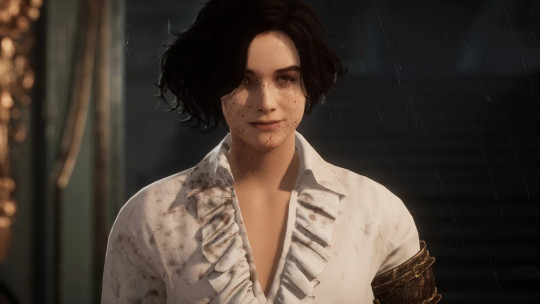
If the Arm of God has the ability to restore things to their original state (which is how I interpreted it), that would mean Carlo looked different from P at the point of his death, meaning that P's skin can't be Carlo's.
Of course, if Geppetto did use human skin for P, but not Carlo's, that would make things quite complicated, as it would be extremely difficult to find someone who looks almost exactly like Carlo. Nevertheless, there's one fan theory I'd still like to talk about: Someone on Reddit actually proposed that Carlo might have had a twin brother once, whose soul got transferred into the lamp by Sophia.
I actually had a similar theory about Gemini before the game came out, although I never shared it publicly because I couldn't find any support for it other than Gemini's name and his death in the original book. Basically, the gist of it was that Gemini is the soul of Geppetto's dead son, which got separated from its body and somehow encased in the lamp.
Although this assumption is definitely outdated since we now know that Carlo is Geppetto's son, we do have many left-over questions about Gemini. (Some character development for Gemini is actually one of the things at the top of my wish list for the DLC; as far as characters go, I felt like Gemini was the game's single weak point, and I wish they would've utilized him more.) In fact, it almost seems like there was originally going to be an amnesia subplot for Gemini, judging by some of his comments. For example, we've got the remark about the fairy tale book at the Hotel, but despite remembering there was a person who particularly adored it, Gemini can't recall who it was. Then, we have this very interesting comment down at the Relic of Trismegistus where Gemini remembers that "someone was dragged away from here", but again can't tell precisely who.
Unfortunately, the game never builds upon these comments, and they're pretty much left standing as they are. In fact, I can't help the impression that this might be part of a cut storyline - even Sophia says that Gemini is "unique" and "more than just a guide", and Gemini himself states that he's a friend of Sophia's, and that she "woke him up the last time she was there" - although, once again, he doesn't remember the exact circumstances.
Now, I've noticed that "P is Carlo's twin brother" AUs are quite popular in the fandom, but I'd like to mention there's nothing from the game that hints at Carlo having a twin brother (at least, to my knowledge). Still, it is quite an interesting theory - if the assumption that it was Carlo who particularly loved the fairy tale about the wooden puppet is true (based on Geppetto's comment during the fight with the Nameless Puppet that he should've taken more time to read him from his "favorite book"), it would explain why Gemini, his former twin brother, knows about it. However, if it really was Sophia who transferred Gemini's soul into the lamp, it prompts the question of the exact circumstances of his death. Given that Geppetto was willing to murder an entire city just for Carlo's revival, I wouldn't put it past him to sacrifice his other, perhaps not-so-favorite son for his endeavor - perhaps that's why P looks very similar, but not identical to Carlo.
Still, it's probably best if you take all of this with a grain of salt, as even compared to my original theory that P might have human skin, it's pretty exotic at best. Also, given that Gemini is directly mentioned in a memory scene that presumably takes place at the Monad Charity House makes this even more questionable. At least, I think it's highly unlikely that Gemini is Carlo's twin brother if he accompanied the mysterious Stalker - on the other hand, it seems a bit strange that Gemini would know about Carlo's favorite book if they only knew each other what appears to be such a short amount of time, especially when their relationship didn't start on good terms. Again, nothing is for certain, as we don't see Gemini physically appear in the memory scene - the only thing that seems to be confirmed is that Gemini also was a human once (at least I can't imagine what a cricket lamp is supposed to do against two unruly school boys).
Other possible alternatives
So, let's say Geppetto didn't actually use human skin for Pinocchio (which, to be honest, would be a relief) - why would he decide to make P look slightly different from Carlo?
One reason I can think of is that he designed P as a kind of "idealized" version of Carlo - judging by his comment before the final battle, Geppetto seems to have been discontent with Carlo's "mischievous" behavior, so maybe he used that opportunity to make him the "picture-perfect son" he always wanted.
Then again, given how rarely Geppetto saw him, I wonder if he even knew what Carlo looked like at the point of his graduation. When he retrieved his dead body, perhaps Carlo's face was disfigured beyond recognition, and all Geppetto had to work with were some old pictures/photos and his own memory.
If that was the case, it would make sense that P's outer appearance slightly differs from Carlo. Still, Geppetto was confident his plan would work out, that the resemblance would be enough to trigger Carlo's memories - but for whatever reason, it didn't, be that because of physical discrepancies or because Carlo was already gone.
Conclusion
In the end, no matter what Geppetto did, the fact remains that it was an insult - not only to Carlo, but also to P.
From the moment he first opened his eyes, P was forced to live in another person's skin (perhaps even literally), with no other choice being offered to him. His entire existence is essentially a lie, being expected to fill the role of someone he just isn't. Moreover, in trying to revive Carlo, what Geppetto actually did was soiling his memory - the mere notion that a living person can be replaced is beyond disrespectful, and to let innocents die in pursuit of this madness is an atrocity I have no words for. Even if Geppetto did all of this out of regret for having neglected Carlo and not spending more time with him, let me spell out one thing Nick Carraway already said in The Great Gatsby: You can't repeat the past.
However, what was given to you at birth is not everything you have to be, and what others expect from you is not what you have to become. In my own way, I love Pinocchio very dearly, but that love extends far beyond pretty looks. I relate to his struggle, and I would do anything to aid him in becoming his own person. Whatever choice he makes for himself, I will support it, and no matter if human or puppet, I'm going to love him just the way he is.
Resources:
Anette Beyer's "Faszinierende Welt der Automaten - Uhren, Puppen, Spielereien" ("Fascinating world of automata - clocks, dolls, playthings")
About Jacques de Vaucanson
On clockwork automata in general
#lies of p#lies of p lore#lore theories#lies of p pinocchio#lies of p carlo#lies of p geppetto#automaton#I feel dirty just writing about this#but I had this fan theory for AGES and finally had to get it off my chest#then again it's just Geppetto being an obsessive creep so nothing new under the sun
121 notes
·
View notes
Text
HOMESTUCK: BEYOND CANON 6/12 NEWS POST
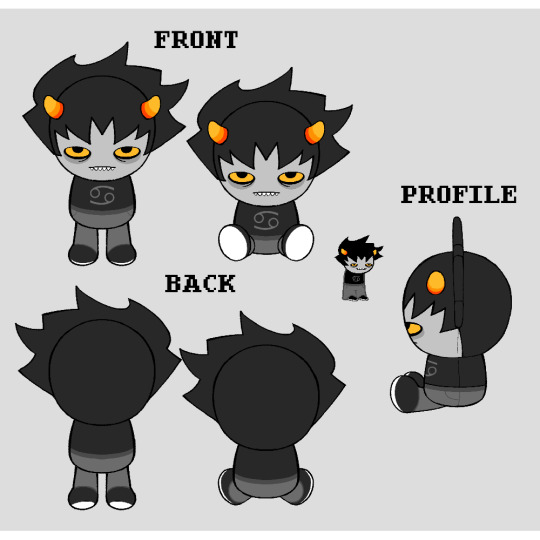
Hi, James here. Happy American Karkat day. European Karkat day, of course, being on the 6th of December. That’s how birthdays work. Don’t look it up.
Some of you may have noticed I am going to be on a stream with a “Virtual Tuber.” Depending on when exactly this goes up, that might actually be going on right now. If you are coming from over there it is very likely you are just now learning we are still doing Homestuck in 2024. Welcome back. You missed a lot but don’t look any of that up either.
What news for the birthday boy? As you may have seen across various platforms we’re partnering with Makeship, and launched a petition for a Highly Marketable Karkat Vantas Plush! The way this works is, they gauge interest by seeing if we can get 200 people to pledge they’ll buy it before the company commits to producing anything. Their business model allows them to do this at no up-front cost to us which is good because it takes a lot of money to manufacture and ship things. Once we reach our initial goal they then move forward with production and do design revisions, prototyping, etc. They send us a little sample and once we’re all approved and on the same page they do a limited pre-order run. For the first 399 pre-orders we get a 10 percent revenue share, which then changes to 30 percent once it hits 400. You might be thinking “Hey man, that's not very much!” and you’d be right, but they cover all manufacturing and fulfillment and shipping costs. And I don’t own a warehouse. So. This is fine with me.
I did promise to try and be more transparent with what's going on behind the scenes, even when it is boring. The thought process here is that, while less lucrative overall than producing and shipping ourselves this will allow us to try out more merch options. We’ve designed some apparel, and are working out something with Andrew and the usual merch guys. This might take a while, I am still new to this. That Vinyl is still on the back burner as we wait for a few holdouts that sort of make or break things. (There are people who are notoriously hard to get in contact with, so it is taking a while and I overestimated my ability to get this done in a timely manner while in poor health. That's on me.)
The whole idea here is to get you guys some cool stuff, and to pay my team more. Right now the Patreon is doing alright, and we’re trying out some new exclusives over there. Music previews, merch previews, and things like that for paying members. Nothing required to enjoy the comic, and things people will all see eventually. Since I’m trying to pay my team as fairly as possible I split everything we make evenly. Right now, for each team member it comes out to a few hundred bucks each per month which is pretty nice for getting to work on Homestuck, but isn’t exactly a liveable wage. And you see how much work they put into it. I want to give them the world, short of that at the very least a fair wage for all the work they do. Also I don’t know if you’ve noticed but a sandwich costs $19 now for some reason. That in mind if you are a company or private individual and want to pay me to promote your product let's talk. We can work something out. I will put it in Homestuck. I will make Rose Lalonde say she loves the bold refreshing taste of Diet Mtn Dew G’raha Tia Blast. I am not joking. This is my solemn vow. Maybe it's time to bring back the “Your Fantroll Gets Put In Homestuck” deal.
Anyway, two updates this month. I Like this schedule, so it looks like we’ll be keeping it up for the near future.
So to Summarize the key points so there’s no room for confusion:
Karkat Plush Makeship petition (the pre-pre-order, even) is now live
Trying out this style of limited run merch to see what's possible
Apparel incoming, not sure when
Still trying to work out details with musicians, sorry.
Fun new Pateron exclusives, including music and merch previews. Maybe more?
Open to more collabs
Sticking to shorter, more frequent updates for now.
Ok, thanks everyone have a good one.
#homestuck#hs#413#612#karkat#homestuck karkat#karkat vantas#vinyl#music#fyp#homestuck archive#mspa#APPAREL......NOT JUST SHIRTS.... WE'RE SO BACK...#homestuck 2#hsbc
56 notes
·
View notes